[SOLVED] How Do I Fix Safari Certificate Error on Mac?
Safari, the default web browser on Mac, is known for its seamless browsing experience and robust security features. However, there are times when you might encounter a pesky “Certificate Error” while trying to access certain websites. These errors can be frustrating, but they’re usually a result of security measures designed to protect you from potentially harmful websites. In this guide, we’ll walk you through the common causes of Safari certificate errors on Mac and provide step-by-step solutions to help you resolve them.
Quick Navigation:

Part 1: Understanding Safari Certificate Errors
Part 2:common causes of safari certificate errors, part 3: how do i fix invalid certificate error on mac.
An “Invalid Certificate Error” on Mac, specifically when encountered in a web browser like Safari, indicates that there is an issue with the SSL/TLS certificate presented by a website. SSL (Secure Sockets Layer) and its successor TLS (Transport Layer Security) are cryptographic protocols that provide secure communication over networks, such as the Internet. These protocols ensure that the data exchanged between a user’s device and a website’s server is encrypted and secure.
SSL/TLS certificates play a crucial role in this process by validating the authenticity of a website and establishing a secure connection. When you visit a website, your browser checks the website’s certificate to verify its identity. If the certificate is valid, properly issued by a trusted Certificate Authority (CA), and not expired, your browser establishes a secure connection. However, if there’s an issue with the certificate, you’ll see an “Invalid Certificate Error.”
Certificate errors in Safari occur when the browser detects an issue with the SSL/TLS certificates used by a website to establish a secure connection. SSL/TLS certificates are digital documents that validate the identity of a website and encrypt data exchanged between the user and the website. When Safari encounters a problem with these certificates, it displays an error message to prevent users from accessing potentially unsafe websites.
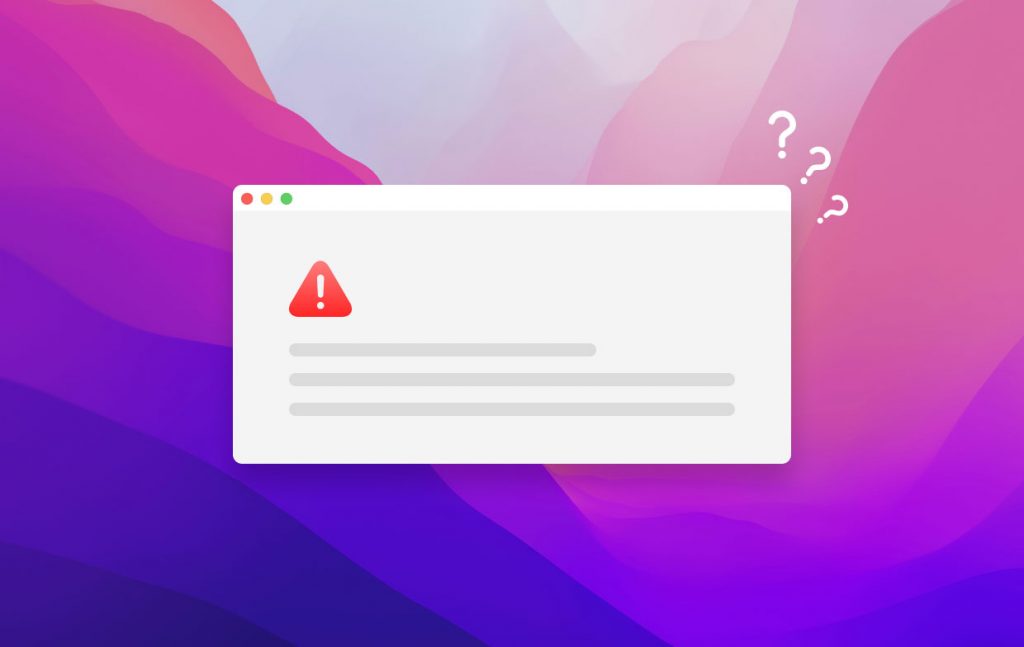
There are a few common scenarios that can trigger an “Invalid Certificate Error” , Explore our step-by-step guide on resolving safari certificate errors and enjoy uninterrupted browsing.
Expired Certificate: SSL/TLS certificates have an expiration date. If the certificate presented by the website has expired, your browser will flag it as invalid.
Untrusted Certificate Authority: If the certificate is not issued by a recognized and trusted Certificate Authority, your browser will treat it as invalid.
Certificate Chain Issues: SSL/TLS certificates are often issued in a chain, with an intermediary CA and a root CA. If any part of this chain is not properly configured or trusted, it can lead to an invalid certificate error.
Hostname Mismatch: The certificate is issued for a specific domain or hostname. If you’re trying to access the site using a different URL, your browser might consider the certificate invalid.
Self-Signed Certificates: Some websites use self-signed certificates instead of those issued by trusted CAs . While they can provide encryption, they’re not automatically trusted by browsers, resulting in an invalid certificate error.
Certificate Revocation: If the website’s certificate has been revoked due to security concerns, your browser will consider it invalid.
Mismatched Public and Private Key: If there’s a mismatch between the public key in the certificate and the corresponding private key on the server, it can lead to an invalid certificate error.
It’s important to note that while encountering an invalid certificate error can be frustrating, these errors are designed to protect users from potentially harmful websites and secure their data. In some cases, you might be able to proceed to the website if you’re certain it’s legitimate, but exercise caution when doing so.
If you encounter an invalid certificate error, it’s recommended to ensure that you’re accessing legitimate and secure websites. If you’re uncertain about the legitimacy of a website or the nature of the error, it’s best to avoid proceeding and potentially exposing your personal information to security risks.
It’s important to take these warnings seriously, as they are designed to protect you from potentially harmful websites and unauthorized access to your data. If you’re certain that the website you’re trying to access is legitimate, you can proceed with caution. However, exercise vigilance and ensure you’re visiting secure websites to avoid falling victim to online scams or security breaches.
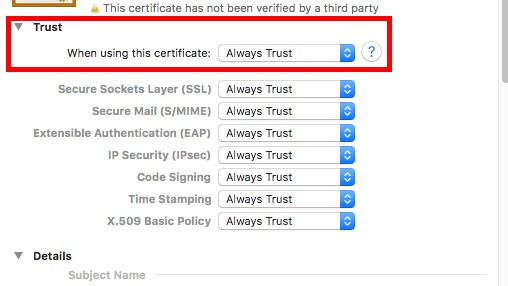
Fixing an “Invalid Certificate Error” on your Mac involves troubleshooting the underlying issues related to SSL/TLS certificates. Here’s a step-by-step guide to help you resolve this error:
Check Date and Time Settings: Click on the Apple menu in the top-left corner of your screen and select “System Preferences.” Choose “Date & Time” and ensure that the option to “Set date and time automatically” is enabled. An incorrect system date and time can trigger certificate errors.
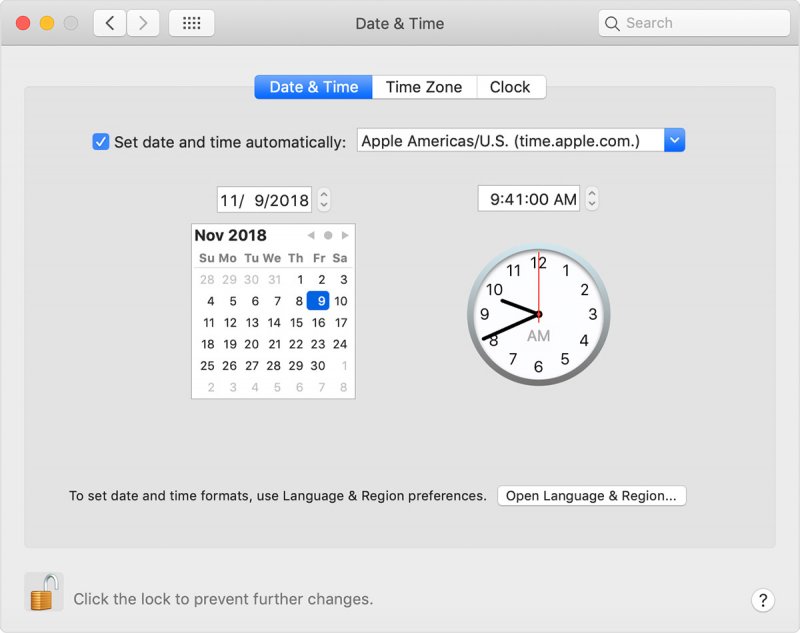
Clear Safari Cache and Cookies : Open Safari and click on “Safari” in the top menu. Select “Preferences” and navigate to the “Privacy” tab. Click “Manage Website Data” and remove stored data for the affected website. Cached data can sometimes cause certificate errors.
Update Safari: Outdated browsers can sometimes have issues with certificate validation. Check for updates by clicking the Apple menu, selecting “System Preferences,” and then choosing “Software Update.” Install any available updates for Safari.
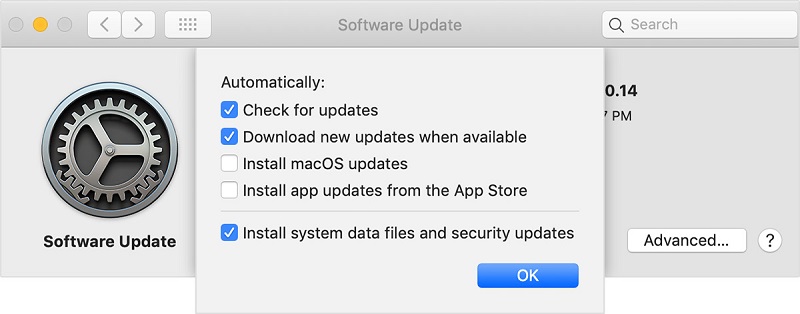
Check the Website URL: Ensure you’re accessing the website using the correct URL and domain. Mismatched URLs can trigger certificate warnings.
Use a Different Browser: If the error persists in Safari, try accessing the website using a different browser like Google Chrome or Mozilla Firefox. This can help determine if the issue is specific to Safari.

Proceed with Caution: If you’re certain that the website is legitimate and you want to proceed despite the certificate error, you can often do so by clicking on the “Advanced” or “Show Details” option (if available) on the error page. However, exercise caution when bypassing warnings.
Check the Certificate Chain: Click on the “Advanced” or “Show Details” option on the error page to view the certificate details. Verify that the certificate chain is complete and issued by a trusted Certificate Authority. If there are any issues with the chain, it could trigger the error.
Contact Website Support: If you continue to experience the error, reach out to the support team of the website you’re trying to access. They might be able to provide insight or resolve the issue from their end.
Check for Network Interference: If you’re on a network with strict security settings, proxies, or firewalls, they might interfere with SSL/TLS connections. Try accessing the website from a different network to see if the error persists.
Update macOS: Ensure your macOS is up to date. Sometimes, system updates can include security patches that affect SSL/TLS certificate validation.
Scan for Malware or Adware: Use reputable antivirus or antimalware software to scan your Mac for potential malware or adware that might be causing certificate errors.
Remember that while some certificate errors can be bypassed, it’s crucial to exercise caution and only proceed if you’re confident about the legitimacy of the website. Invalid certificate errors are designed to protect your data and privacy, so avoid accessing websites that trigger these warnings unless you’re certain they’re safe.
Encountering a certificate error in Safari on your Mac might be an inconvenience, but it’s a sign that your browser is working to keep you safe. By following the steps outlined in this guide, you can often resolve these issues and continue browsing securely. Remember, while there are workarounds like bypassing warnings, it’s always best to ensure that you’re visiting legitimate and secure websites to protect your personal information and sensitive data.
Latest Articles
- Perfect Microsoft Access Alternative for Mac Users
- How to Convert FLAC to MP3 on Mac and Windows
- Troubleshooting Apple Music Not Working on Your Mac
- How to Pause Watch History YouTube [2023 Full Guide]
- How to Delete Your iCloud Account: A Step-by-Step Guide
- PNG Vs JPG: A Battle of The Popular Image Formats
- Troubleshooting Tips: How to Connect Beats to Mac
Want to highlight a helpful answer? Upvote!
Did someone help you, or did an answer or User Tip resolve your issue? Upvote by selecting the upvote arrow. Your feedback helps others! Learn more about when to upvote >
Looks like no one’s replied in a while. To start the conversation again, simply ask a new question.
Make Safari accept an untrusted certificate
I'm using Safari 10.0.1 on macOS Sierra 10.12.1
I'm trying to view use Safari to view a web server I use for staging content. Since it's only a staging server, I have a certificate with an untrusted root (it's from the letsencrypt staging environment). It used to be that when I tried to load a site like this from Safari, it would alert me, but I could still accept the insecure certificate and continue on to the site.
Lately, I just get an error that "Safari can't establish a secure connection to the server," and that's it. There's no option to load it anyway. There's no lock icon in the URL bar to look at the certificate. I've been using Chrome to load this site because it has the behavior I used to see in Safari. Is there any way to get the old behavior back?
MacBook Pro with Retina display, macOS Sierra (10.12.1)
Posted on Nov 18, 2016 4:03 PM
Posted on Nov 20, 2016 11:42 AM
Thanks for the reply. Now I realize that the title of the post is inaccurate. I don't want Safari to accept the certificate. I want it to prompt me whether or not it should load a site with an untrusted certificate.
The certificate is not in the keychain. I suppose a workaround would be to add it to the keychain and then set it to always trust. I would rather have the old behavior back, where I get a warning with the option to continue or cancel loading the page.
I get the behavior I want on other staging sites. I'm thinking I might regenerate my certificate for the problematic site and see if that fixes it.
Loading page content
Page content loaded
Nov 20, 2016 11:42 AM in response to Eric Root
Nov 19, 2016 7:16 AM in response to feck
From Safari Help
Change the trust settings of a certificate
You can view or change a certificate’s trust policies in Keychain Access.
Open Keychain Access for me
In the Category list, select a category.
Select a certificate, then choose File > Get Info.
Click the Trust disclosure triangle to display the trust policies for the certificate.
To override the trust policies, choose new trust settings from the pop-up menus.
Safari Certificate not recognized
Certificate isn’t being accepted
Jun 12, 2017 7:36 AM in response to feck
Found the answer in this thread .
Safari -> Preferences -> Privacy -> Manage Website Data…-> Remove All

[SOLVED] How Do I Fix Invalid Certificate Error on Mac?

Written By Jordan Baldo
Last updated: May 15, 2024
Almighty writing expert who is proficient in analyzing Mac issues and providing efficient solutions.
Safari, Google Chrome, Firefox, and Opera are all browsers used to surf the web. But sometimes you might ask, “ How do I fix invalid certificate error on Mac ?” This error can usually happen with different websites you’re trying to access. Usually, the browsers work great in terms of browsing the web. But, the error happens when the browser tries to verify the website’s specific identity. And if it gets an issue, you get an invalid certificate error.
Contents: Part 1. What is an Invalid Certificate Error on Mac? Part 2. Why Does It Say My Certificate Is Invalid? Part 3. How to Fix Invalid Certificate Error on Mac? Part 4. Summary
This guide will give you the details to solve the expired certificates on Mac. In this way, you can view the website you want to check out, especially if it’s a necessity for work or school.
[Quick Guide] 8 Ways to Fix Invalid Certificate Error on Mac
- Ensure placing the right domain name match
- Update your browsers to the latest version
- Fix invalid certificate error on Mac using Keychain
- Correct your system date and time
- Modify certificate trust settings
- Check firewall or antivirus security software
- Clear cache, cookies, and browsing history
- Disable invalid SSL certificates within browsers
Free Tool to Clear Browser on Mac & Fix Error
Part 1. What is an Invalid Certificate Error on Mac?
Let’s dig into a little overview before we answer the “How do I fix invalid certificate error on Mac” Websites are very important these days.
There are a lot of cyber attacks happening. An SSL or TLS certificate is necessary for website owners. Usually, it’s a gauge of your website’s security and safety. If a website doesn’t have an SSL certificate, browsers such as Safari, Google Chrome, and Firefox, will show an error to viewers: the certificate for this server is invalid. you might be connecting to a server that is pretending.
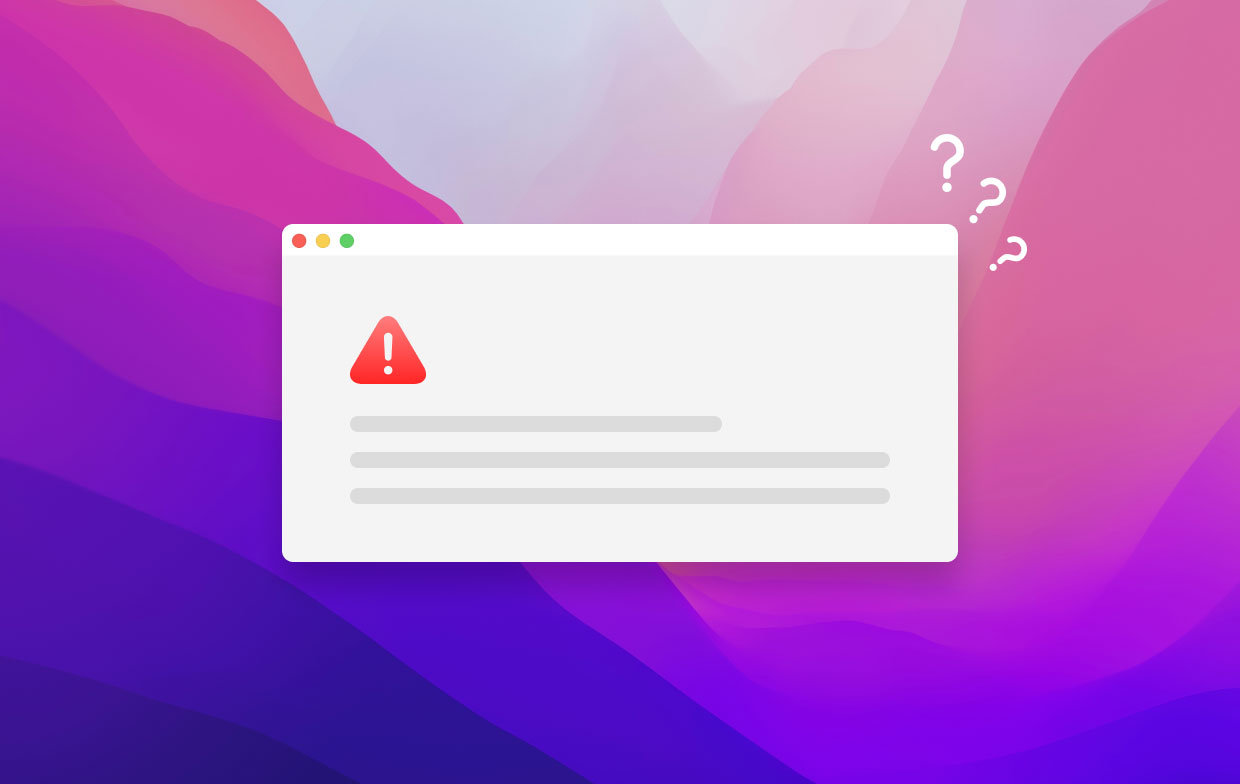
So, what exactly is an Invalid Certificate Error or an Invalid SSL Certificate Error? This error is found if the browser cannot recognize the SSL certificate installed on the website. For example, some users may see a message like " Safari can't verify the identity of the website xxxx " when they navigate in the browser. Or the "activate mac the certificate for this server is invalid" error.
The browser cannot say that the certificate authority is valid or it cannot recognize it. This means the installed SSL cannot be trusted and the site may be dangerous.
Then what is certificate trust settings Mac? How do I get my Mac to trust a certificate ? To find certificates on Mac, open Utilities > Keychain Access > login keychain > choose Certificates from the menu bar. Now you can double-click the certificate you want and then choose different the "Trust" settings.

An Invalid SSL Certificate Error means it cannot recognize or fails to identify the websites’ installed SSL. The certificate authority may not be enlisted in their “list” of acceptable or trusted CAs . Usually, popular certificate authorities include Sectigo, Comodo, and DigiCert.
Part 2. Why Does It Say My Certificate Is Invalid?
There are other reasons why you are seeing the invalid error certificate. Here, we will discuss some of those reasons for you to solve the invalid certificate error problem on Mac. Check them out below before we show ways on how to fix SSL error:
- If you access a domain that is mismatched, browsers may show the invalid SSL certificate error.
- You signed the certificate in these two ways, through a certificate that’s self-signed or through a trusted, unknown source. In this case, the browser will show the said error. We will tell you the answer to “How do I fix invalid certificate error on Mac”.
- The certificate of the website is currently not valid or the certificate has already expired.
- In rare cases, if the website possesses an SSL certificate of the incorrect format, browsers will display it as invalid.
- Misconfigured SSL or TSL certificates can be a result of this error showing up. This misconfiguration can usually happen during installation.
- The certificate installed is revoked or bought illegally.
- Antivirus software or your firewall may be blocking the SSL connection.
- The site may be using SHA-1 encryption. This case is usually rare.
- The browser may not be able to verify the installed certificate’s signature.
- Broken structure of the SSL or TLS certificate.
Another reason for you to ask the question, “How do I fix invalid certificate error on Mac” is the possibility of having a broken certificate chain of trust. Well, it happens in a few instances such as the following:
- A root certificate authority (CA) that is actually not verified.
- Expired root or even intermediate certificate.
- It has an actual self-signed certificate in the chain.
- The chain actually doesn’t terminate with a root certificate that’s trusted.
Part 3. How to Fix Invalid Certificate Error on Mac?
After we have given you the reasons for the occurrence of this issue, you may be able to figure out some of the things you have to do. But, to make it easier for you, we will give you 8 solutions to solve the certificate problem, and quickly get your Mac to trust a certificate or update the certificate.
Solution 01. Ensure You Place the Right Domain Name Match
Works for: All Browsers
If you got a mismatched domain name, you will get an invalid certificate error on Mac. The same goes for Windows. The first thing you should do is to make sure that you type in the correct match of the domain name of the website. It’s pretty obvious, but this one does the trick.
Solution 02. Update Your Browser to Latest Version
Another obvious solution! How do I fix invalid certificate error on Mac? Well, you should try to update your browsers. This solution works for Safari, Google Chrome, Opera, and Firefox, among others. Here are the steps on how to update each browser.
How to Update Safari?
- Open the Apple Menu. Head towards the Apple menu on your Mac computer.
- Choose Software Update. After that, click on the option labeled Software Update.
- Install all the updates available for your Safari browser.
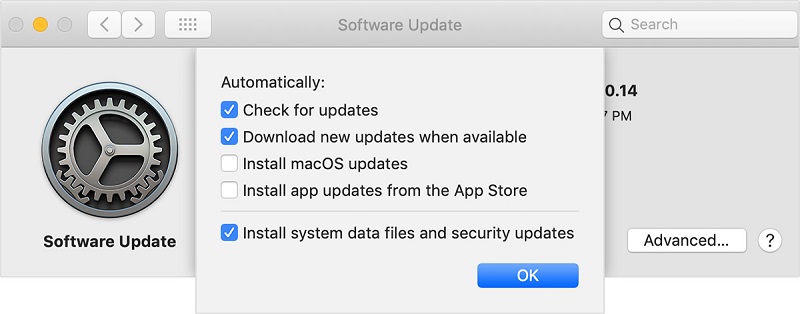
How to Update Google Chrome
- Launch Chrome. Open Chrome and click More that looks like three dots aligned vertically.
- Click Update. Click the option to “ Update Google Chrome ”.
- Click the option to Relaunch.
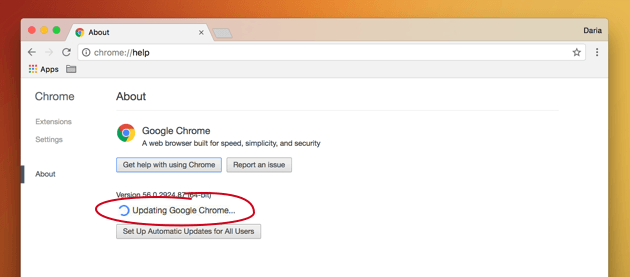
How to Update Firefox
- Launch Firefox. Open Firefox on your computer.
- Open the Menu. Click the Menu button that appears like three lines .
- Choose "About Firefox". Choose the option that says “ Help ” and then click “About Firefox” on the menus.
- Wait for an Update. The final thing to do is to wait for the automatic update to finish.
- Restart your Firefox browser afterward.
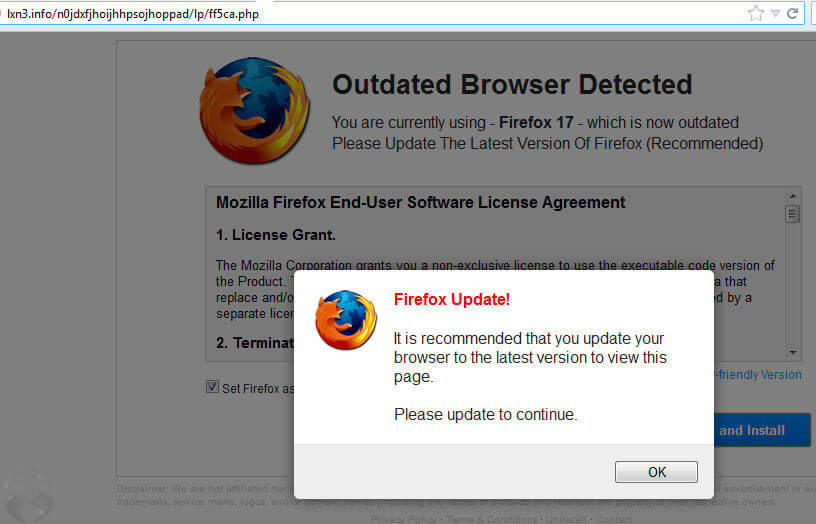
Solution 03. Fix Invalid Certificate Error on Mac Using Keychain
You can actually turn towards the Keychain Access to fix an invalid certificate error on Mac. After that, you should verify and then repair the certificates. We are referring to the certificates contained within the user account that’s active in Mac.
How do I fix invalid certificate error on Mac using Keychain? Here’s how to do it.
- Quit Browsers. These include Safari, Chrome, etc.
- Open Spotlight. Press the CMD + SPACEBAR buttons to open Spotlight. Type in Keychain Access to launch the app.
- Go to the Keychain Access Menu. Then, you should select Keychain First Aid .
- Enter Password. Then click the Verify box to check it. Then, click the “Start” button.
- Click the radio box called Repair and then choose Start again.
- Restart Safari. And try to visit the said website again.
Solution 04. Correct System Date and Time
Works For: All Browsers
There may be a problem with your time settings. Thus, how do I fix invalid certificate error on Mac? Well, you should adjust the time and settings to the correct one. Here are the steps on how to do that easily:
- Connect To the Internet. This will allow you to get an accurate time.
- Quit Safari or any browser that you use.
- Launch Apple Menu. Open the Apple Menu and then visit the System Preferences option.
- The next step is to choose “ Date & Time ”. After that, you should check the actual box that says you should automatically set your date and time. If it’s already checked, you should uncheck it and check it back again.
- Open Your Browser Again, then go to the page you want to visit.

Solution 05. Modify Certificate Trust Settings
This is another answer to the problem “How do I fix invalid certificate error on Mac”. If the issue persists for particular certificates alone you have to make sure you trust the actual certificates you wish to connect to.
Once you are sure you trust it, you should modify its trust settings. This will enable its authentication to actually proceed. Here’s how to do this step by step:
- Launch Keychain Access. Do this by going to the Applications and then Utility folder. Select your actual login keychain.
- Click and open Certificates. Go to the category labeled Certificates and then find the certificate you wish to connect to. This is done by searching the service’s domain name on the search box. Or, you can scroll through the list.
- Check out Certificate status and Tweak.
- If the certificate you want to connect to has an X symbol (colored red), this has to mean that it is invalid or has expired. What you have to do in this case is to right-click that particular certificate and then delete it from the computer’s system.
- If the said certificate has a Plus (+) symbol (colored blue), you must tweak the settings. You should choose System Defaults as the trust setting for it. To do this, you should open the certificate within Keychain Access by double-clicking its icon. Then, expand the section for Trust settings. Then, select Use System Defaults located at the top part of the menu.
Solution 06. Check Firewall or Antivirus Security Software
You should make sure that the firewall settings do not block that particular site. So, this is another solution to the question, “How do I fix invalid certificate error on Mac”. In addition, make sure the antivirus software doesn’t block it as well. This will allow you to ensure that the site is accepted by your entire system.
Solution 07. Clear Cache, Cookies and Browsing Data
Here, you should remove cookies , cache, and browsing history from your browser. This may include clearing login history or passwords as well. The steps are different for each browser. However, the premise is exactly the same. You simply have to clear it through the menu, options, or settings, section of your browser.
Tips: We recommended using the Mac cleaning tool - PowerMyMac to help you improve your browser's online experience and reset all browser settings to default. Its " Privacy " module will clean up all cookies, caches, and history, eliminate deceleration reasons, clear privacy traces to protect your confidential data, and more.
Get A Free Trial Now!
You can try this tool for free to fix the Invalid Certificate Error on Mac.
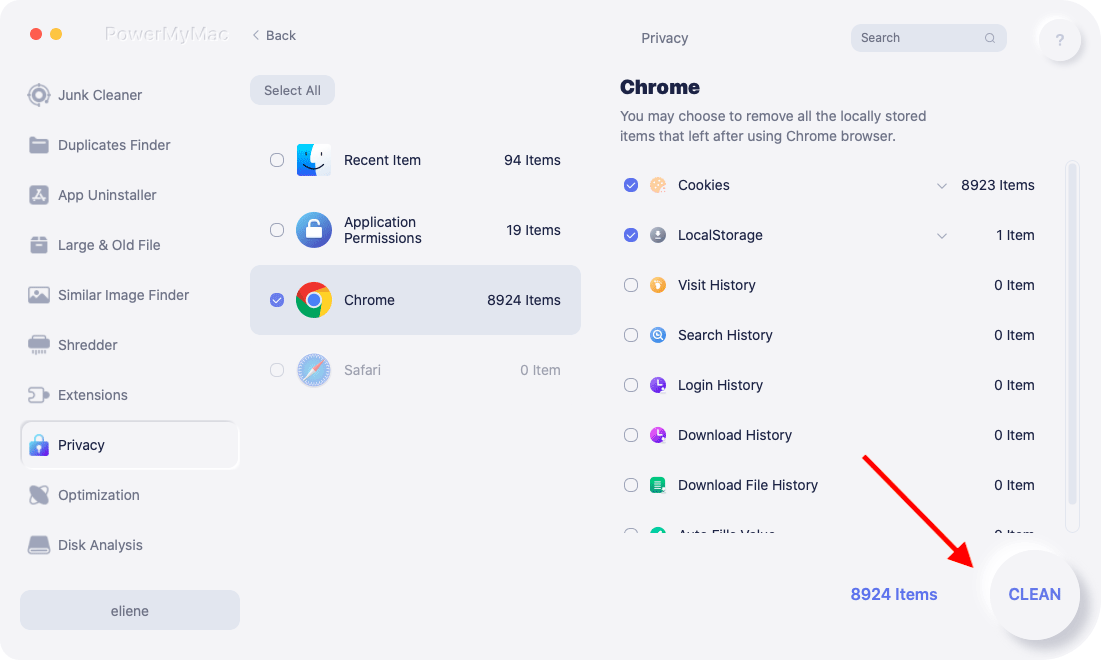
Solution 08. Disable Invalid SSL Certificate within Browsers
Works For: Google Chrome, Firefox
This is the last thing you should do. This is because the website you’re trying to access may be dangerous. In this case, you’re removing the protection offered by the browsers. Can I fix invalid certificate error on Google Chrome and Firefox ? The answer is yes. But Opera, Safari, and Microsoft Edge don’t allow it. This is because it may be a risk to your system.
Tips & Tricks
Troubleshooting, how to fix safari “this connection is not private” warnings.

Are you receiving an error message saying “This connection is not private” when you’re trying to access a website in Safari from iPhone, iPad, or Mac? Many users have seen this error at some point as they browse the web, and this can be bypassed or ignored quickly fixed regardless of what device you use.
This message pops up when Safari’s security check on the website’s certificate fails. You’ll likely face this issue when you’re visiting a website that uses an expired certificate, or HTTP instead of HTTPS when it’s not configured properly. The difference between the two is that the older HTTP doesn’t have an SSL certificate, and therefore they aren’t ‘secure’ by default. However, SSL certificates aren’t valid forever, so you might still face this issue on HTTPS sites when the SSL certificate has expired, if it’s setup incorrectly, or if it’s not issued by a legitimate certificate authority. Finally, you can also face this issue if the device viewing the website has a clock that isn’t set to the proper time, since that breaks the certificate check too.
In any event, if you use Safari on an iPhone, iPad, or Mac, you can still bypass the “This connection is not private” warning and access the site.
Important note: if you encounter a “This connection is not private” error message on a banking website, financial services site, email site, or anything where critically important data is submitted or exchanged, there may be something else going on and you should not attempt to bypass the warning message. Instead, check the URL to make sure it is correct, try again later, or contact the company directly.
How to Fix Safari “This Connection Is Not Private” Warnings on iPhone & iPad
Bypassing this error is actually a pretty simple and straightforward procedure, but most people don’t seem to read the error message completely. Just follow the steps below to get started.
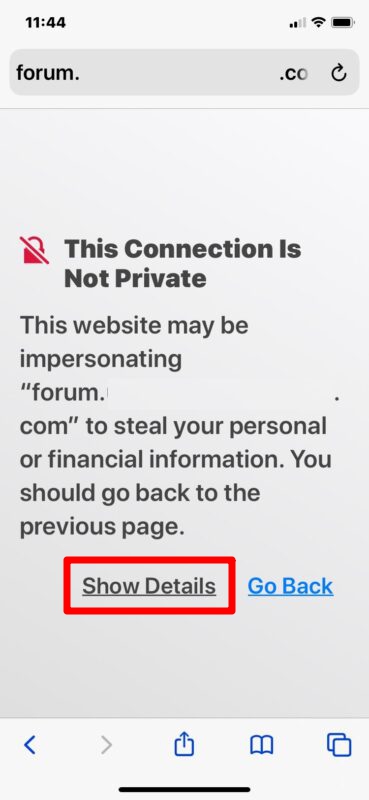
Now, you’ll be able to view all the contents of the website like normal, but you’ll notice a “Not Secure” notice in the address bar .
How to Fix Safari “This Connection Is Not Private” Warnings on Mac
The procedure to bypass the warning is pretty similar on a macOS system too. Here’s how it works:
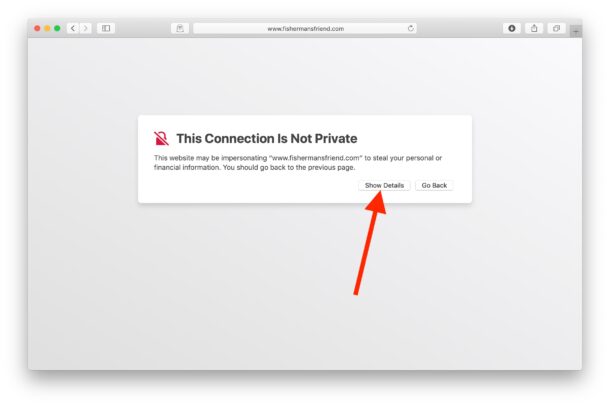
And there you have it, you’re viewing the site. Again on the Mac you’ll find the “Not Secure” website message in the address bar, indicating you should not transmit any important personal data like banking details, login information, etc on the URL. But if it’s simply an informational site where you are not inputting any personal data, there usually isn’t much concern.
Now you know how easy it is to fix “This connection is not private” warnings in Safari.
Although this warning is mostly a website-related issue, entering the wrong URL, an incorrect system clock, a VPN issue, or even corrupted browser cache can sometimes also be the reason why you see this warning. Therefore, you might want to double-check that you have the proper URL entered, that the device has the date and time and clock set properly (you can check in Settings on iPhone/iPad or System Preferences on Mac), and consider clearing your Safari browser cache . To do this on an iPhone or iPad, head over to Settings -> Safari and tap on “Clear History and Website Data”. For clearing the Safari cache on your Mac , just go to Safari -> Preferences from the menu bar. Additionally, if you’re using a VPN on your device, turn it off and visit the site again to see if you’re still getting the warning. If you read the warning message carefully, you’ll see that fixing your clock can also resolve this issue too.
You may see this error with or without browsing in Private mode in Safari too .
Similarly, you can run into a connection not private error in Google Chrome, with a similar resolution though the Chrome issue is almost always related to improper SSL certificates, expired certs, or a time/date error on the device itself.
We hope you were able to stop getting this error on your iPhone, iPad, and Mac. How often do you get these warnings while browsing in Safari? Share your experiences, thoughts, and advice in the comments.
Enjoy this tip? Subscribe to our newsletter!
Get more of our great Apple tips, tricks, and important news delivered to your inbox with the OSXDaily newsletter.
You have successfully joined our subscriber list.
Related articles:
- Use Private Browsing Mode in Safari for Mac OS X on a Per Window Basis
- How to Completely Disable Private Browsing in iOS on iPhone and iPad
- How to Tell if Safari Private Browsing is Enabled When in Dark Mode for MacOS
- How to Use Private Relay in Safari to Hide Your IP address on iPhone & iPad
10 Comments
» Comments RSS Feed
Not so simple. When you go to “visit website anyway” it then tells you website has been blocked. We don’t even have a choice.
So really, this article is misleading.
The article is accurate Heidi.
A blocked warning is a different warning from “This connection is not private”, you might be experiencing a blocked website form a firewall or from your ISP.
There is no way to access this website. The warnings do not give access in any way shape or form. It’s a Godaddy site but my iPad Pro 11 will not allow me to access. There is not “enter anyway” or “visit Webite” button, the site is basically completely locked from me and I have to use my Microsoft Windows 10 to get there.
What website are you trying to access, and what is the exact error message that you see?
It is possible that your iPad Pro clock is set improperly, which can also cause issues with connections to websites. Do other HTTPS sites load fine on the iPad?
Yeah, does anyone know how to do it now?
visit website option is no longer available.
This crap has been going over and over and over and they never fix it, same with the audio crackling noise. These days nothing really works with Apple, it’s unbelievable the software they put out, zero QA literally.
My Safari (13.1.2, MacOS 10.13.6, MacBookPro8,1) just goes into an infinite loop. I keep on getting the warning, clicking on the “visit the website”, supplying the password, over and over, and I never actually see the web page. I have to switch to Google Chrome or Firefox to be able to see it. This behavior has been consistent over multiple Safari and OS versions.
Mine always asks for a password to make a change to Keychain in order to bypass the warning. Is there a way to fix that? I always switch to another browser which is quite inconvenient
Leave a Reply
Name (required)
Mail (will not be published) (required)
Subscribe to OSXDaily
- - How to Install Java on Mac with M3, M2, M1 Apple Silicon Chip
- - Install & Run iTunes, Aperture, or iPhoto in MacOS Sonoma with Retroactive
- - 17 Numbers Keyboard Shortcuts for iPad
- - How to Find a Misplaced Apple Watch with iPhone’s Ping My Watch
- - How to Install VMWare Tools in Windows on VMWare Fusion for Mac
- - PSA: Updating to MacOS Sonoma or iOS 17 May Enable iCloud Keychain
- - iOS 17.5.1 & iPadOS 17.5.1 Update Released to Fix Reappearing Deleted Photos Bug
- - MacOS Ventura 13.6.7 & macOS Monterey 12.7.5 Updates Available
- - iOS 16.7.8 & iPadOS 16.7.8 Updates for Older iPhones & iPads Available
- - iOS 17.5 & iPadOS 17.5 Updates Released with Bug Fixes
iPhone / iPad
- - How to Change the Voice of ChatGPT on iPhone, Mac, iPad
- - sysmond on Mac Using High CPU? Here’s the Likely Reason & How to Fix It
- - How to Factory Reset Mac (MacOS Sonoma & Ventura)
- - How to Fix the Apple Watch Squiggly Line Screen
- - What Does the Number Badge Mean on Microsoft Edge Icon?
- - How to Hide iPhone Keyboard When It’s Covering Buttons & Won’t Go Away

About OSXDaily | Contact Us | Privacy Policy | Sitemap
This website is unrelated to Apple Inc
All trademarks and copyrights on this website are property of their respective owners.
© 2024 OS X Daily. All Rights Reserved. Reproduction without explicit permission is prohibited.
How-To Geek
How to fix "your connection is not private" errors.
Make sure your device isn’t causing these errors!
Quick Links
What does "your connection is not private" mean, how to fix "your connection is not private" error, how to bypass the "your connection is not private" error, privacy error variations and codes explained, protecting your privacy online, key takeaways.
To fix "Your connection is not private" errors on Chrome, Firefox, Edge, or Safari, you can clear the cache, update the device operating system, or ensure your computer clock is correct. Plus, you can check if a browser extension or your antivirus is interfering.
While browsing the web, you're likely to encounter the "Your connection is not private" error occasionally. But what does this privacy error mean, how do you fix it, and can you bypass it? Here's everything you need to know.
The "Your connection is not private" error occurs when your web browser cannot confirm the identity of the website you're trying to visit or finds its encryption weak. As a result, your browser assumes the website to be unsafe because it may have been compromised or has a configuration error. It stops short of establishing a connection and presents you with the "connection is not private" warning.
Related: Internet Connection Not Working? 10 Troubleshooting Tips
This isn't any run-of-the-mill warning because your browser needs a secure connection to the website to ensure that no one can snoop on the information you are exchanging with that website.
There can be several reasons why the web browser can't initiate a secure connection. But all of them relate to the SSL certificate of the website.
What Is an SSL Certificate?
To create an encrypted connection with a website, a web browser, such as Chrome or Firefox, first attempts to verify that website's SSL certificate . It's a digital certificate that verifies the identity and security of a website and includes information such as the domain name, the organization name, the issuing authority, the certificate expiry date, and a public key. Once satisfied with the SSL certificate details, the browser generates a random session key and uses the public key included in the certificate to encrypt it. This information is then shared with the website server that uses its private key to decrypt it, following which both can safely communicate without worrying about someone intercepting the data.
Related: How To Troubleshoot Internet Connection Problems
Why Is My Connection Not Private?
A problem with a website's SSL certificate can cause your connection to be not private. For example, if the certificate has expired, is invalid, or is not set up correctly, the browser deems the website unsafe. There can also be other issues, such as a mismatch between the actual domain of the webpage and the domain mentioned in the certificate. Or, in the worst-case scenario, a malicious actor has compromised the website server.
Besides the problems on the website's end, issues with your computer clock, Wi-Fi network, or browser cache can also lead to errors such as "this connection is not private."
Although several privacy or SSL errors will require intervention from the website owner, you can try to get rid of the "Your connection is not private" error by attempting the following fixes.
Check Your Computer's Clock
One of the causes for the "ERR_CERT_DATE_INVALID" or "SEC_ERROR_EXPIRED_CERTIFICATE" error codes is the wrong system date or time. You can remedy this by updating your computer's date and time or by choosing the option to update it automatically.
If you are using Windows, you can right-click the date and time in the taskbar and choose the "Adjust Date and Time" option. Once in the "Date & Time" settings, you can choose to enable "Set time automatically" to get the correct date and time from Windows server, or you can click on "Set the Date and Time Manually" to change the date and time on your computer yourself. Confirming the time zone while you're in the settings is also a good idea.
On a Mac, you'll find "Date & Time" settings in System Settings, which you can access by clicking on the Apple menu in the top-left corner of your screen. Once in "System Settings," look under General for "Date and time." Like Windows, you can enable the "Set time and date automatically" option here or manually set the date and time.
Sign In to the Public Wi-Fi Portal
Some public Wi-Fi hotspots require you to log in to access free internet. But to reach the sign-in page, you often have to open a website. But if you try to open a secure website, your browser may throw a privacy error as it doesn't have access to the internet to check the SSL certificate. So it's better to open a website that doesn't require a secure connection. HTTP Forever is an excellent option to bookmark for when you might need a "nonsecure" website to open the Wi-Fi captive portal.
Once you're signed in to the Wi-Fi portal, your browser will stop saying your connection is not private.
Related: How to Speed Up Your Internet Connection
Temporarily Disable Your Antivirus
If you use an antivirus that provides a feature like HTTPS protection, HTTPS scanning, Encrypted Web Scan, or Encrypted connections scanning, it may interfere with the browser's attempts to create a secure connection. So you can temporarily disable the antivirus to see if the issue goes away. If the page works after turning off the antivirus, you can contact the developer for a permanent solution or switch to a different antivirus software, like Windows Defender .
Open the Website in the Browser's Incognito Mode
Some browser extensions can also cause the browser to show the "connection not private" error. You can confirm this by opening the website or webpage in Incognito mode , which typically keeps all extensions disabled. An extension is likely responsible if the webpage opens without any privacy errors.
Then, you can disable all extensions in the regular mode and switch on one extension at a time to find the culprit. Remember, while all extensions are disabled by default in Incognito mode, there is an option to enable them . So ensure all extensions are disabled before you open the webpage in Incognito. An Incognito window is known as an InPrivate window on Edge and a Private window on Firefox and Safari .
Clear the Browser Cache
Your web browser's cache stores temporary data from the websites you visit. But sometimes, this cache can become corrupted or outdated, which could hamper a browser's ability to verify a website's SSL certificate properly. To fix this, you need to clear your browser's cache and cookies.
To clear the cache on Chrome , click the three-dot menu icon, then navigate to More Tools > Clear Browsing Data. Next, select "All time" from the time range drop-down and check the boxes next to "Cookies And Other Site Data" and "Cached Images And Files." Finally, click on the "Clear data" button.
Similarly, in Edge, click the three-dot menu icon, then navigate to Settings > Privacy, Search, and Services > Choose What to Clear. Next, select "Cached Images and Files" from the list, and click "Clear Now" to clear Edge's cache and cookies .
Firefox users will have to click on the hamburger icon and navigate to Settings > Privacy & Security > Cookies and Site Data > Clear Data. Then, check the boxes next to "Cookies and Site Data" and Cached Web Content," and click "Clear."
If you are using Safari and want to delete your data , click on "History" in the top menu and select "Clear History." You can then select "all history" from the drop-down and hit the "Clear History" button.
Update the Operating System
Privacy errors can also be triggered by outdated system software. So it's a good idea to update your device to the latest operating system version. Even if this doesn't fix the issue, you should still keep the device software up to date. To help you do this, we have guides on updating Windows 11 , updating Windows 10 , updating macOS , updating a Chromebook , updating Ubuntu , and updating iPhones and Android phones too .
Contact the Website Owner
If the problem persists after trying the fixes mentioned above, there is nothing you can do on your own. It's best to contact the website owner or administrator with the privacy error you are facing and ask them to fix it.
Related: What Is a 500 Internal Server Error, and How Do I Fix It?
While it's typically not recommended to bypass the "your connection is not private" error, you can make an exception if you trust the website and your connection to it. You can also skip the error if you understand the technical reason why the browser has generated that particular error and are willing to risk communicating over a vulnerable connection.
To bypass the security warning, click "Advanced" on Chrome, Firefox, and Edge, or "Show Details" on Safari. Then, you can choose to continue to the webpage.
Related: How to Spot a Fraudulent Website
The "connection not private" errors may look different depending on which web browser you are using. And sometimes, these errors are also accompanied by technical-sounding error codes that can be worrying. If you're trying to troubleshoot the exact cause of your privacy error, use these codes to investigate further.
"Your Connection Is Not Private" Error in Chrome
A privacy error on Chrome typically appears as a "Your connection is not private" message accompanied by a red warning symbol. But often, the message will also include one of the following error codes.
- NET::ERR_CERT_AUTHORITY_INVALID : The website's SSL certificate is either self-signed or from an untrustworthy certificate authority (CA).
- ERR_CERT_COMMON_NAME_INVALID : This error occurs when the domain name mentioned in the SSL certificate doesn't match the website's domain name.
- NET::ERR_CERT_WEAK_SIGNATURE_ALGORITHM : The weak signature algorithm error is a result of using the SHA-1 signature hashing algorithm by the SSL CA. SHA-1 was proven insecure in 2017, and now SHA-2 has become the standard hashing algorithm.
- ERR_CERTIFICATE_TRANSPARENCY_REQUIRED : The CA must add all SSL certificates to Certificate Transparency (CT) logs. When that doesn't happen, website visitors will encounter the certificate transparency required error code.
- ERR_SSL_VERSION_OR_CIPHER_MISMATCH : You'll encounter an SSL version or cipher mismatch error when the Transport Layer Security (TLS) protocol version used by the website server is older or it's using RC3 ciphers.
- ERR_CERT_DATE_INVALID : If the expiry date mentioned in the SSL certificate is older than the system date, you may encounter this error.
- ERR_CERT_SYMANTEC_LEGACY : This error appears because Chrome no longer trusts SSL certificates issued by Symantec before June 1, 2016.
- ERR_CERT_REVOKED : The primary reason for this error code is the revocation of a website's SSL certificate by the CA.
Related: How to Speed Up Chrome and Fix Errors Without Reinstalling It
"Your Connection Isn't Private" Error in Edge
The privacy errors in Edge browser look similar to Chrome, and you get the red warning symbol along with the "Your connection isn't private" message and the related error codes. But sometimes, you may also get a "The connection for this site is not secure" warning page.
"Warning: Potential Security Risk Ahead" Error in Firefox
Firefox uses a number of privacy or security warning messages when it encounters an unsafe or misconfigured website. "Warning: Potential Security Risk Ahead" is one of the common warnings. But you may also get "Secure Connection Failed," "Did Not Connect: Potential Security Issue," or "Your connection is not secure." Most of these warnings are typically accompanied by some explanation about the potential security issue or an error code. Here are some common error codes you may see on Firefox.
- SSL_ERROR_UNSUPPORTED_VERSION : Firefox no longer supports TLS protocols older than version 1.2. So if a website uses version TLS 1.1 or older, you will get this error code.
- SEC_ERROR_UNKNOWN_ISSUER : If the SSL certificate issuing authority is unknown to Firefox or the certificate is self-signed, the browser shows this error code. MOZILLA_PKIX_ERROR_SELF_SIGNED_CERT is another error code shown when a website has a self-signed certificate. Or you may get MOZILLA_PKIX_ERROR_ADDITIONAL_POLICY_CONSTRAINT_FAILED code if the website uses an SSL certificate from Symantec, including those issued under the GeoTrust, RapidSSL, Thawte, and Verisign brands.
- SEC_ERROR_EXPIRED_CERTIFICATE : As the name suggests, you will get this error code when Firefox believes the SSL certificate has expired.
- SEC_ERROR_REVOKED_CERTIFICATE : This one is self-explanatory. You will typically see when the certificate issuing authority has revoked the SSL certificate of a domain.
- SSL_ERROR_BAD_CERT_DOMAIN : Firefox shows the "bad cert domain" error when the domain or sub-domains mentioned in the certificate don't match the webpage domain. It typically happens when all sub-domains aren't mentioned in the SSL certificate.
- SEC_ERROR_REUSED_ISSUER_AND_SERIAL : If the SSL certificate of the website has the same serial number as another certificate.
"This Connection Is Not Private" Error in Safari
If you are trying to visit a potentially unsafe or misconfigured website on Safari, the browser presents a "This connection is not private" warning page. Unlike Chrome, Firefox, or Edge browser, it doesn't have an error code, but you can click "Show Details" to find more information about the issue.
A secure connection between your browser and a website is vital for the safe exchange of information . This is why modern web browsers warn you when you are trying to visit a potentially unsafe website. But often, a problem with your web browser or system can also result in a privacy error.
You can try the fixes mentioned above to resolve any issues with your system. But if none work, it's best to contact the website owner and wait for it to get fixed to avoid risking your private information.
- PRO Courses Guides New Tech Help Pro Expert Videos About wikiHow Pro Upgrade Sign In
- EDIT Edit this Article
- EXPLORE Tech Help Pro About Us Random Article Quizzes Request a New Article Community Dashboard This Or That Game Popular Categories Arts and Entertainment Artwork Books Movies Computers and Electronics Computers Phone Skills Technology Hacks Health Men's Health Mental Health Women's Health Relationships Dating Love Relationship Issues Hobbies and Crafts Crafts Drawing Games Education & Communication Communication Skills Personal Development Studying Personal Care and Style Fashion Hair Care Personal Hygiene Youth Personal Care School Stuff Dating All Categories Arts and Entertainment Finance and Business Home and Garden Relationship Quizzes Cars & Other Vehicles Food and Entertaining Personal Care and Style Sports and Fitness Computers and Electronics Health Pets and Animals Travel Education & Communication Hobbies and Crafts Philosophy and Religion Work World Family Life Holidays and Traditions Relationships Youth
- Browse Articles
- Learn Something New
- Quizzes Hot
- This Or That Game
- Train Your Brain
- Explore More
- Support wikiHow
- About wikiHow
- Log in / Sign up
- Computers and Electronics
- Basic Computer Skills
Common SSL Certificate Errors and How to Fix Them
Last Updated: April 1, 2024 Fact Checked
As an Administrator
This article was co-authored by Gonzalo Martinez and by wikiHow staff writer, Travis Boylls . Gonzalo Martinez is the President of CleverTech, a tech repair business in San Jose, California founded in 2014. CleverTech LLC specializes in repairing Apple products. CleverTech pursues environmental responsibility by recycling aluminum, display assemblies, and the micro components on motherboards to reuse for future repairs. On average, they save 2 lbs - 3 lbs more electronic waste daily than the average computer repair store. This article has been fact-checked, ensuring the accuracy of any cited facts and confirming the authority of its sources. This article has been viewed 63,695 times.
SSL certificates are special files used to encrypt connections to remote servers like websites. An SSL certificate error can occur if your web browser has a problem validating a certificate. If you get an SSL certificate error when visiting a website, there are a few things you can do to bypass it, including setting the date and time correctly, adding the website to a trusted list, and clearing cache and cookies. If you administer a website that's generating an SSL error, you'll need to resolve the issue on your server.
Fixing SSL Certificate Errors
- Make sure your computer's date and time are correct.
- Add the website to the list of trusted sites.
- Disable certificate revocation checks.
- Clear your SSL state.
- Clear your web browser's cache.
- Restore your web browser to its default settings.
- Contact the website administrator.

- NET::ERR_CERT_AUTHORITY_INVALID
- NET::ERR_CERT_COMMON_NAME_INVALID
- NET::ERR_CERT_REVOKED
- ERR_SSL_WEAK_EPHEMERAL_DH_KEY
- ERR_SSL_VERSION_OR_CIPHER_MISMATCH

- Right-click the date and time in the taskbar.
- Click Adjust date and time .
- Ensure Set time automatically is checked.
- Ensure Set timezone automatically is checked.

- Press the Windows key .
- Type internet options .
- Click Internet Options .

- Click the Security tab.
- Click the checkmark icon above "Trusted sites."
- Click Sites .
- Copy and paste the URL for the website below "Add this site to the zone."
- Click Add .
- Click Close .
- Click Apply .

- Click the Advanced tab.
- Uncheck "Check for publisher's certificate revocation" below "Security."
- Uncheck "Check for server certificate revocation" below "Security."

- In the Internet Options window, click the Content tab.
- Click Clear SSL state .

- You can also try a different web browser to see if that resolves the issue. For example, if you're using Microsoft Edge , try installing Chrome and checking to see if you can view the website there. If you get an SSL error on two different browsers, there's probably an issue with the certificate itself.

- Click the Apple icon.
- Click System Settings or System Preferences .
- Click General .
- Click Date & Time .
- Ensure "Set date and time automatically" is enabled.

- Press Command + Spacebar to open Spotlight search.
- Type keychain .
- Click Keychain Access to open the app.
- Click Login in the left pane.
- Click Certificates under "Category" in the menu to the left.
- Double-click the certificate that is giving you trouble.
- Expand the menu below "Trust."
- Select Always trust next to "When using this certificate."
- Enter your Mac password and click Update settings .
- If the certificate continues to give you trouble, you can right-click it and delete it. [4] X Research source

- Click ' Keychain Access to open the app.
- Click Certificates under "Category" on the left.
- Right-click the SSL certificate that is giving you trouble.
- Click Delete . [6] X Research source

- You can also try a different web browser to see if that resolves the issue. For example, if you're using Safari , try installing Chrome and checking to see if you can view the website there. If you get an SSL error on two different browsers, there's probably an issue with the certificate.

- Also check that the contact information, such as the email, is the same as the one under which your website is registered.
- You can get a wildcard SSL certificate to cover multiple subdomains as well as your main domain.

Expert Q&A
You might also like.

- ↑ https://www.youtube.com/watch?v=mpc-1kIL9ec
- ↑ https://supportcenter.lexisnexis.com/app/answers/answer_view/a_id/1084255/~/clear-ssl-state-on-a-windows-operating-system
- ↑ https://support.zendesk.com/hc/en-us/articles/360000099508-Why-do-I-sometimes-get-incorrect-SSL-certificate-details-for-my-subdomain-
- ↑ https://www.bluehost.com/help/article/clear-locally-stored-ssl#apple
- ↑ https://www.freecodecamp.org/news/an-ssl-error-has-occurred-how-to-fix-certificate-verification-error/
- ↑ https://sematext.com/blog/ssl-certificate-error/
About This Article

- Send fan mail to authors
Is this article up to date?

Featured Articles

Trending Articles


Watch Articles

- Terms of Use
- Privacy Policy
- Do Not Sell or Share My Info
- Not Selling Info
Keep up with the latest tech with wikiHow's free Tech Help Newsletter
Stack Exchange Network
Stack Exchange network consists of 183 Q&A communities including Stack Overflow , the largest, most trusted online community for developers to learn, share their knowledge, and build their careers.
Q&A for work
Connect and share knowledge within a single location that is structured and easy to search.
How do I make Safari automatically use a particular client certificate for an entire site?
Using client certificates with Safari present a number of problems:
- Safari asks to select a client certificate on each page of the site (annoying)
- Safari might even re-ask you to choose a certificate on a page you've already visited, particularly if you have to update your client certificate
How can I fix these issues?
- ssl-certificate
3 Answers 3
Safari's client certificates and related preferences are stored in Keychain Manager with a kind of certificate .
When you select a certificate to use with a web site, it stores another entry in the Keychain Manager with a kind of identity preference . Unfortunately, by default it stores it only for the exact page you were on. Both the name and location are set to the URL of the page.
To fix this, you can just edit one of the identity preference entries and change the where section to the base URL, like https://somesslsite.com/ (the trailing slash is important!). I also update the name to the same thing to prevent confusion. You can then delete all of the other identity preference entries for that site.
If you have a certificate that expired and you've had to add a new one, I would recommend that you delete the old certificate entries and all of the related identity preference entries.
To find certificate and identity preference entries, open Keychain Manager, make sure All Items is selected, and search for the partial URL and/or certificate name as appropriate. You probably don't have many, so if that doesn't work just sort the list by kind and you should be able to find them easily.
NOTE: I'm answer this myself since I figured it out but wanted to persist the knowledge for myself and others.
- 2 Unfortunately, Safari keeps asking for each sub URL... :-/ – Tafkadasoh Sep 16, 2014 at 9:27
- removed comment. DanJs answer already explains that. – Calon Sep 14, 2015 at 13:05
- 1 Not that you have to update the location property. Name is not sufficient. – andy Oct 1, 2018 at 15:16
Partial paths and wildcards are now supported in more recent versions of OS X. So you can use the Keychain Manager to create an identity preference for an entire web site and/or domain.
Partial path example (note that the trailing slash is required!):
Wildcard example:
Full details here (from 'man security' page):
Prior to 10.5.4, identity preferences for SSL/TLS client authentication could only be set on a per-URL basis. The URL being visited had to match the service name exactly for the preference to be in effect. In 10.5.4, it became possible to specify identity preferences on a per-server basis, by using a service name with a partial path URL to match more specific paths on the same server. For example, if an identity preference for " https://www.apache-ssl.org/ " exists, it will be in effect for " https://www.apache-ssl.org/cgi/cert-export ", and so on. Note that partial path URLs must end with a trailing slash character. Starting with 10.6, it is possible to specify identity preferences on a per-domain basis, by using the wildcard character * as the leftmost component of the service name. Unlike SSL wildcards, an identity preference wildcard can match more than one subdomain. For example, an identity preference for the name *.army.mil will match server1.subdomain1.army.mil or server2.subdomain2.army.mil . Likewise, a preference for *.mil will match both server.army.mil and server.navy.mil .
- Worked for me (running Safari 7.0.1 on Mac OS X 10.9.1) – Tafkadasoh Dec 19, 2013 at 11:07
- The "File->New Identity Preference" menu item seems to have disappeared (as of Keychain Access 10.5). Now I can only find it in a contextual menu if I control-click on a certificate. – jhfrontz Jan 29, 2020 at 15:01
- Strange @jhfrontz... I am also running 10.5 and I still see the "File->New Identity Preference...". 4th item down under "New Keychain...". Are you sure you have a certificate selected? – DanJ Jan 30, 2020 at 16:33
- @DanJ aha, thanks. I was expecting it to be a generally available menu item. – jhfrontz Jun 23, 2020 at 14:07
I've been struggling with this myself and the above answer made me realize what was going on.
If you had a certificate for a website and it expired, what you should do is remove the old certificate. Then also remove the identity preference type items for that website. These old items are just as much expired as the certificate is. After you remove them, any new identity preference will be stored and used correctly.
- Remove old certificate
- Remove old certificate's identity preference items
- Add new certificate
Then you can browse to the website, select the new certificate from the list, this will be remembered for that specific web address. Currently we are at Safari 5.1.3 and this version will not use any wildcards for preferences, you will have to add the preference for each change in web address... Hope this helps someone, just putting it out there because I didn't find any complete answer.
- please refer to @apinstein answer for the correct way to do it – dwery Oct 10, 2013 at 12:50
You must log in to answer this question.
Not the answer you're looking for browse other questions tagged safari ssl-certificate ..
- The Overflow Blog
- Can software startups that need $$$ avoid venture capital?
- How to prevent your new chatbot from giving away company secrets
- Featured on Meta
- Testing a new version of Stack Overflow Jobs
Hot Network Questions
- Why can we formally test the relevance assumption of instrument variable?
- How to check for ATM fees when traveling?
- What is a simple way to copy a partition from one list to another list?
- Approximating the length of a circular arc using geometrical construction. How does it work?
- Why does the Wurtz-Fittig reaction occur?
- Which was the first story to feature humans achieving immortality through science and technology advancements?
- How long would today's books last in a post apocalyptic setting?
- Does hill time count faster in KoTH (King of The Hill) if there are more than one person on the hill?
- Today is a prime!
- Forming real positive semidefinite matrices from complex matrices
- The relation between voices in piano pieces
- Is rolling resistance that significant?
- small slanted blackboard math
- Do analog computers exist?
- What is a building with two floors called?
- A Crossworm Puzzle
- C++ static vector implementation
- What does moving into a space mean for a Large or larger creature when it's still affected by an AoE via the squares "behind" it?
- What part of speech is 'really' when it is spoken in a sentence on its own?
- Possibly NSFW? What is an 既成事実?
- What does the '!' button do?
- How sensitive are bathroom sink drain seals to very slight angles in the drain pipe?
- 'Mice IS the scourge of the fields' <-- Plural noun - is/are - predicate noun
- Convert string name to uppercase

- High Assurance
- Enterprise EV
- Wildcard SSL/TLS
- Multi-domain UCC/SAN
- Enterprise EV UCC/SAN
- Code Signing
- EV Code Signing
- Secure Email (S/MIME)
- Client Authentication
- eSigner Document Signing
- NAESB Certificates
Select Language

We hope you will find the Google translation service helpful, but we don't promise that Google's translation will be accurate or complete. You should not rely on Google's translation. English is the official language of our site.
Troubleshooting SSL/TLS Browser Errors and Warnings
- By SSL.com Support Team
- September 10, 2019
- Categories: SSL/TLS , Troubleshooting
- Tags: Error Message
Browser Errors and Warnings
It’s all too common to encounter browser error messages like this when accessing websites:

These messages typically begin with a bold headline stating that Your connection is not private or Warning: Potential Security Risk Ahead . These messages can be frustrating for users and website owners, especially when the owner has gone to the effort to secure their website with an SSL/TLS certificate. Often, these errors are caused by server misconfigurations that are simple to correct once you know the root cause. In this guide, we’ll go through some common misconfigurations and the error messages associated with them in various web browsers. The browsers used to generate these screenshots were:
- Google Chrome 76.0.3809.100 (macOS 10.14.6)
- Firefox 68.0.1 (macOS 10.14.6)
- Safari 12.1.2 (macOS 10.14.6)
- Edge 44.17763.1.0 (Windows 10 Enterprise)
- Internet Explorer 11.379.11763.0 (Windows 10 Enterprise)
The situations we will cover are detailed in the Table of Contents below.
Expired Certificate
In these cases, the server has a certificate installed that has outlived its validity period and needs replacement:
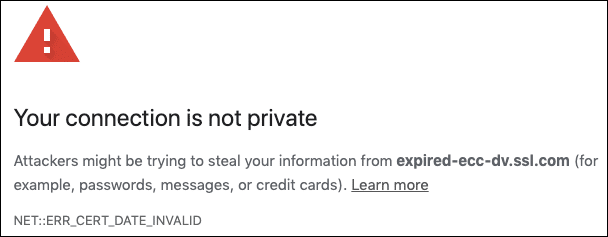
Solution: Renew the website’s certificate. End users who are experiencing this error should also confirm that the date and time are set correctly on their computer.
Domain Name Does Not Match Certificate
In these cases, the web server is presenting a certificate that does not match the domain name the user is attempting to access:

Solution: Make sure that the common name and/or a subject alternative name listed in the certificate matches the website’s domain name.
Incomplete Chain of Trust
If a web server does not have a complete chain of trust including all necessary intermediate certificates installed, these errors can result:

Solution: Make sure that a complete certificate chain is installed on your server. Please see our article on diagnosing and fixing this problem for more information.
Revoked Certificate
Sometimes, due to server compromise or compliance issues, certificates must be revoked before their scheduled expiration date (for an example, see the serial number entropy issue of early 2019). Failing to replace a revoked certificate will lead to these error messages:

Solution: generate a new website certificate chained to a valid, publicly trusted root and intermediate certificates.
- Error Message
SSL.com Support Team

Stay Informed and Secure
SSL.com is a global leader in cybersecurity, PKI and digital certificates. Sign up to receive the latest industry news, tips, and product announcements from SSL.com .
We’d love your feedback
Take our survey and let us know your thoughts on your recent purchase.
- Privacy Overview
- 3rd Party Cookies
This website uses cookies so that we can provide you with the best user experience possible. Cookie information is stored in your browser and performs functions such as recognizing you when you return to our website and helping our team to understand which sections of the website you find most interesting and useful.
For more information read our Cookie and privacy statement .
This website uses Google Analytics & Statcounter to collect anonymous information such as the number of visitors to the site, and the most popular pages.
Keeping these cookies enabled helps us to improve our website.
Please enable Strictly Necessary Cookies first so that we can save your preferences!
8 Ways to Fix SSL Connection Errors on Various Browsers and Platforms

It’s never been easier to obtain a Secure Sockets Layer (SSL) certificate for your website and set it up. But you can still run into SSL connection errors even after installing your certificate correctly and forcing traffic through HTTPS. In many cases, these error messages can drive users away.
Understanding what causes SSL errors will help you prevent them from popping up on your website. You’ll also know what to do if you run into one, depending on the message you see and the browser or OS you’re using.
In this article, we’ll explore what SSL connection errors are and their leading causes. We’ll also discuss their most common types and how you can troubleshoot them.
Let’s get to it!
Check Out Our Video Guide to Fixing SSL Connection Errors
What is an ssl connection error.
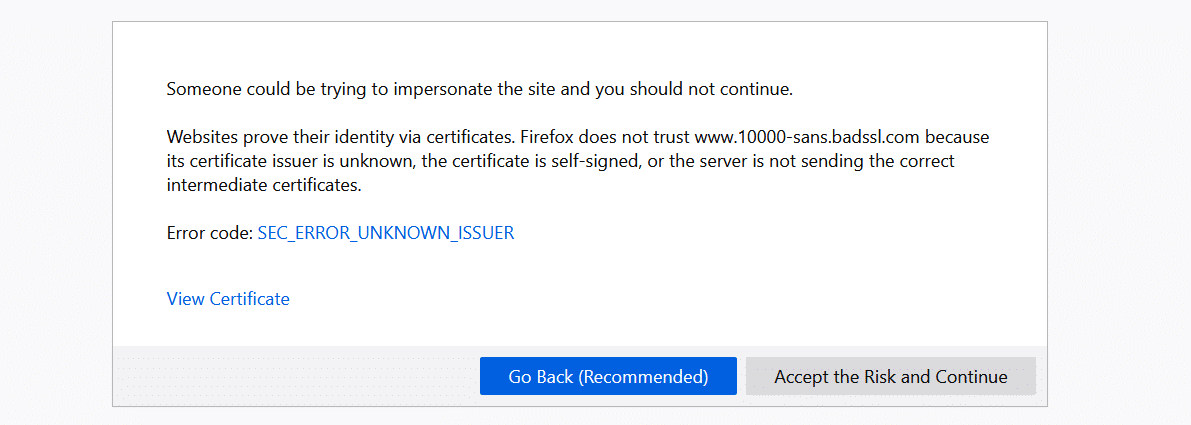
There are several types of SSL connection errors that you may encounter while browning the web. Some of these errors are due to server-side issues, whereas others are because of local configuration problems.
In broad terms, SSL connection errors will prevent you from browsing a website securely over Hypertext Transfer Protocol Secure (HTTPS) . Your browser may allow you to proceed with the connection, but in most cases, it’ll tell you that you’re doing so at your own risk. Without a valid SSL certificate, malicious parties can intercept any data you exchange with the website you’re trying to view.
Some of the most common SSL connection errors that you may run into include:
- NET:ERR_CERT_AUTHORITY_INVALID
- NET::ERR_CERT_COMMON_NAME_INVALID
- NET::ERR_CERT_REVOKED
- SSL Handshake Failed
- ERR_SSL_OBSOLETE_VERSION
- ERR_SLL_PROTOCOL_ERROR
Each type of SSL connection error points towards a different cause. When you run into such a problem, your browser will display a specific message that gives you information about why you see it:
It’s important to note that error messages can vary from one browser to another. The one pictured above comes from Firefox, whereas the one below pops up when we open the same website using Chrome:
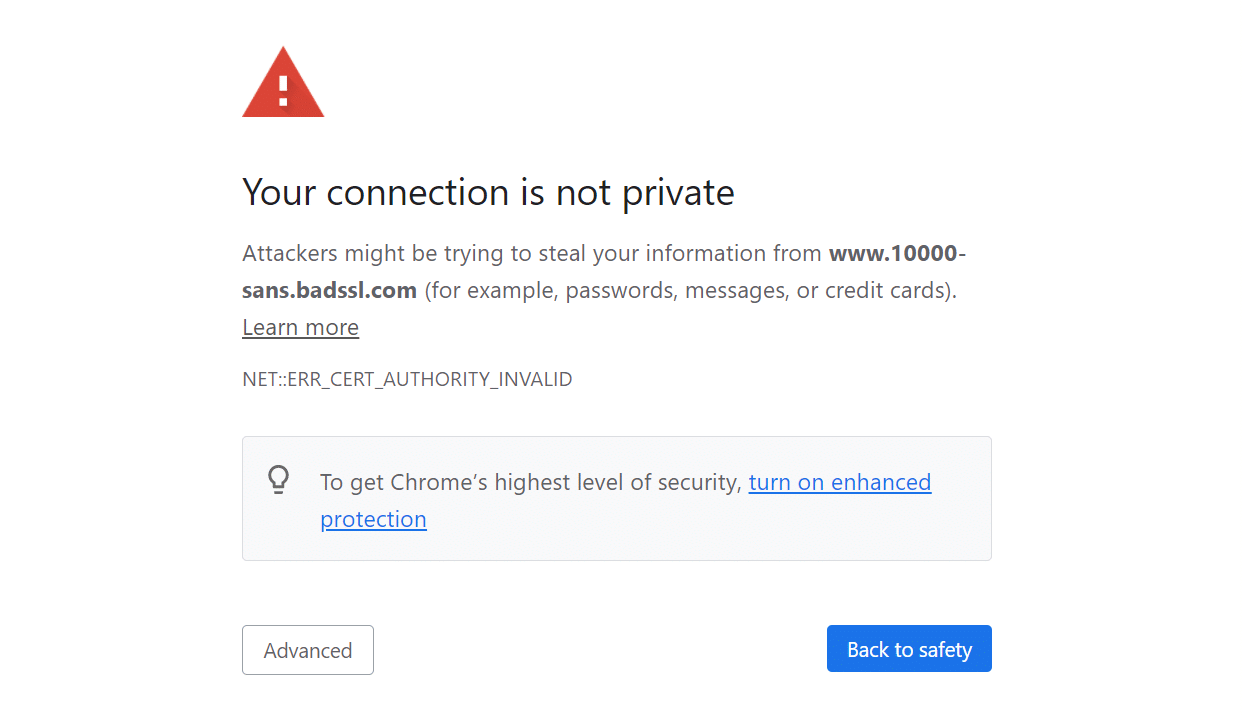
As mentioned before, not all SSL connection errors stem from problems with your server configuration. Your website can have a perfectly valid SSL certificate, but users might still run into errors when accessing it.
Throughout the following few sections, we’ll show you what to do if you’re trying to access a website and you run into SSL connection issues.
How to Fix SSL Connection Errors (8 Methods)
If you’re not in charge of a website, there’s little that you can do when it comes to fixing server-side SSL connection errors. However, some issues can occur due to problems with your local device or browser configuration.
We’ll show you how to fix local issues that cause SSL connection errors using various browsers , mobile OSs, and social media platforms.
Let’s get fixing!
1. How to Fix the SSL Connection Error in Google Chrome
If you run into an SSL connection error in Google Chrome, there are several quick fixes that you can implement.
First off, make sure you’re running the latest version of Chrome. You can update Chrome from within the browser itself , or you can download and install the most recent version from Google Chrome’s website .
Next, check if your system’s time and date are synchronized. If your device’s time is not correct, you may run into SSL connection issues throughout the web because some SSL certificates rely on internal system clocks for validation. An incorrect time or date on your computer can lead to errors as your browser can’t verify these certificates .
On Windows, you can fix the time and date by opening the Settings menu and selecting the Time & Language option:

On the next screen, make sure that both the Set the time automatically and Set the time zone automatically options are enabled. Alternatively, you can select your time zone manually and enable the Set the date and time manually option:
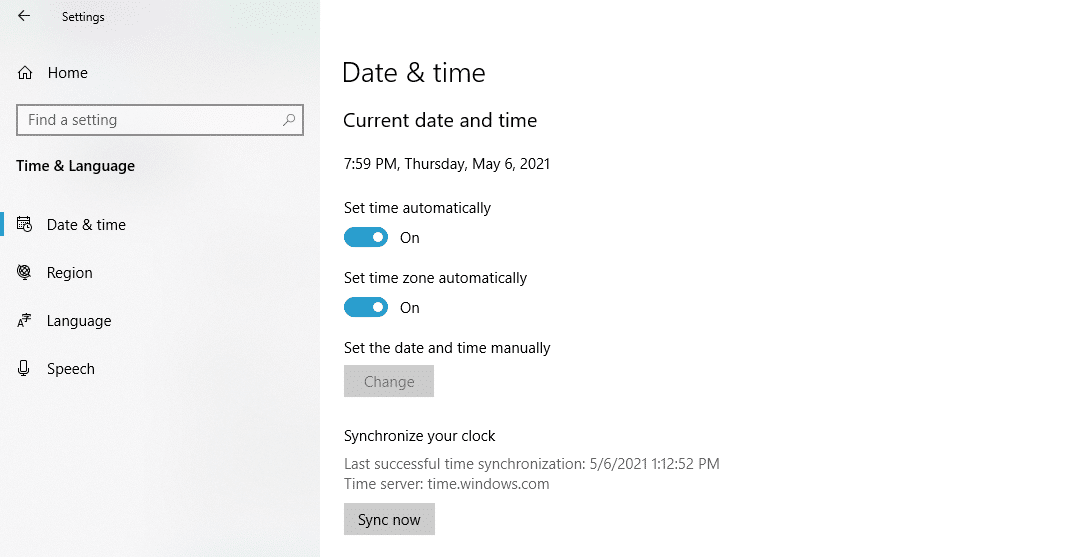
If you’re using Chrome on macOS, open the System Preferences menu by clicking on the Apple icon in the top left corner of the screen. Select the Date & Time option and enable the Set date and time automatically setting:
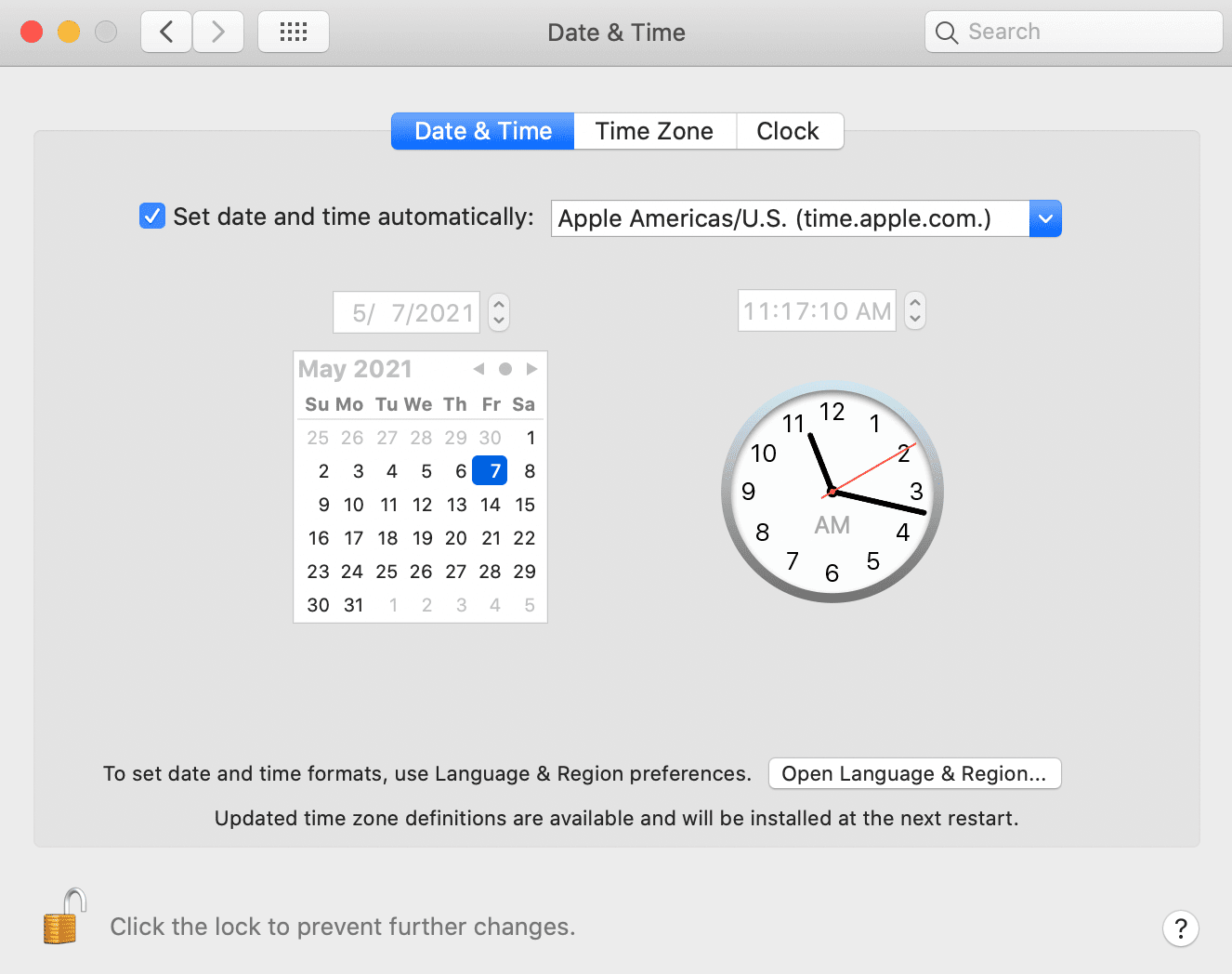
Once you fix the date and time, try accessing the website that showed an SSL connection error in Chrome. If the problem persists, move on to clearing your Chrome cache and cookies . To do so, open the Settings menu and click on Clear browsing data .
A window will pop up, enabling you to select what data you want to clear. If you’re using the Basic settings, select Cookies and other site data and Cached images and files , then hit the Clear data button:
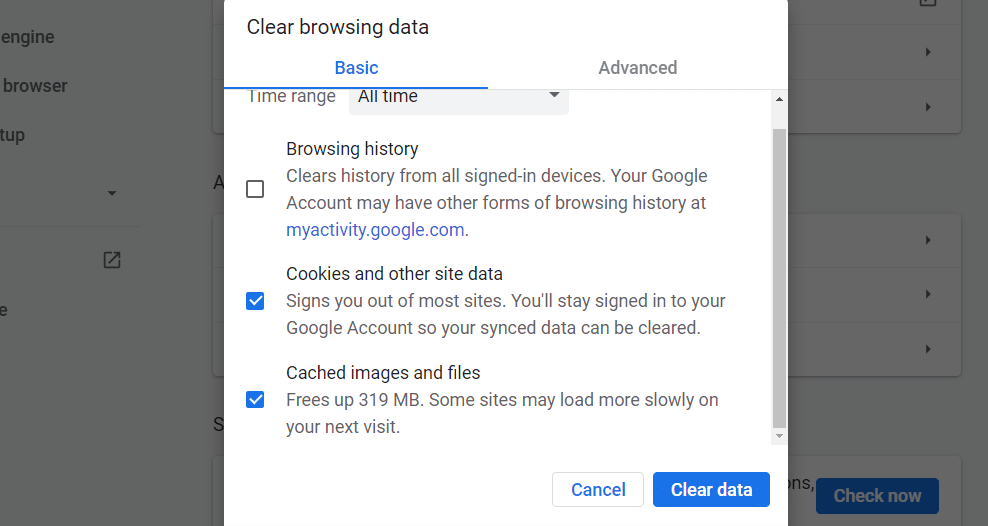
Another fix that you can try is to clear the SSL slate in your operating system. To do so in Windows, open the start menu and search for Internet Options. Click on the result that comes up, and an Internet Properties window will pop up. Jump to Content and click on Clear SSL slate:
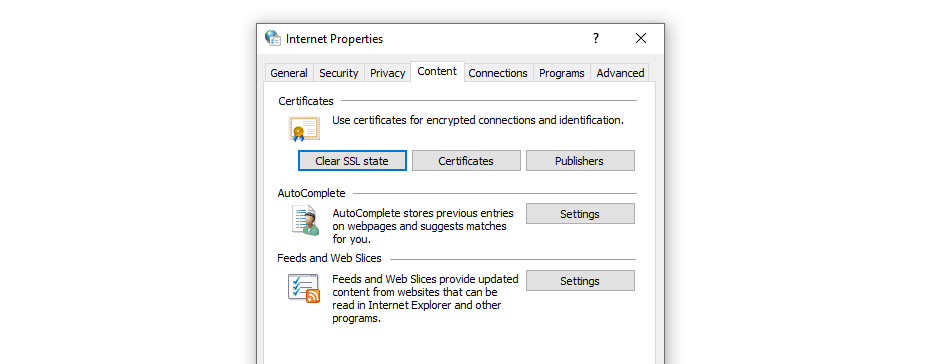
Clearing the SSL slate will remove all of the certificates stored locally on your computer. The next time you reload the website giving you SSL connection errors, the browser will attempt to re-validate its certificate and, in doing so, might clear the error.
If you’re using macOS, clearing your SSL slate works a bit differently. Open your Utilities menu and go to Keychain Access . Select the System option under Keychains in the left-hand menu, and you’ll see an overview of all the SSL certificates that your system stores locally:
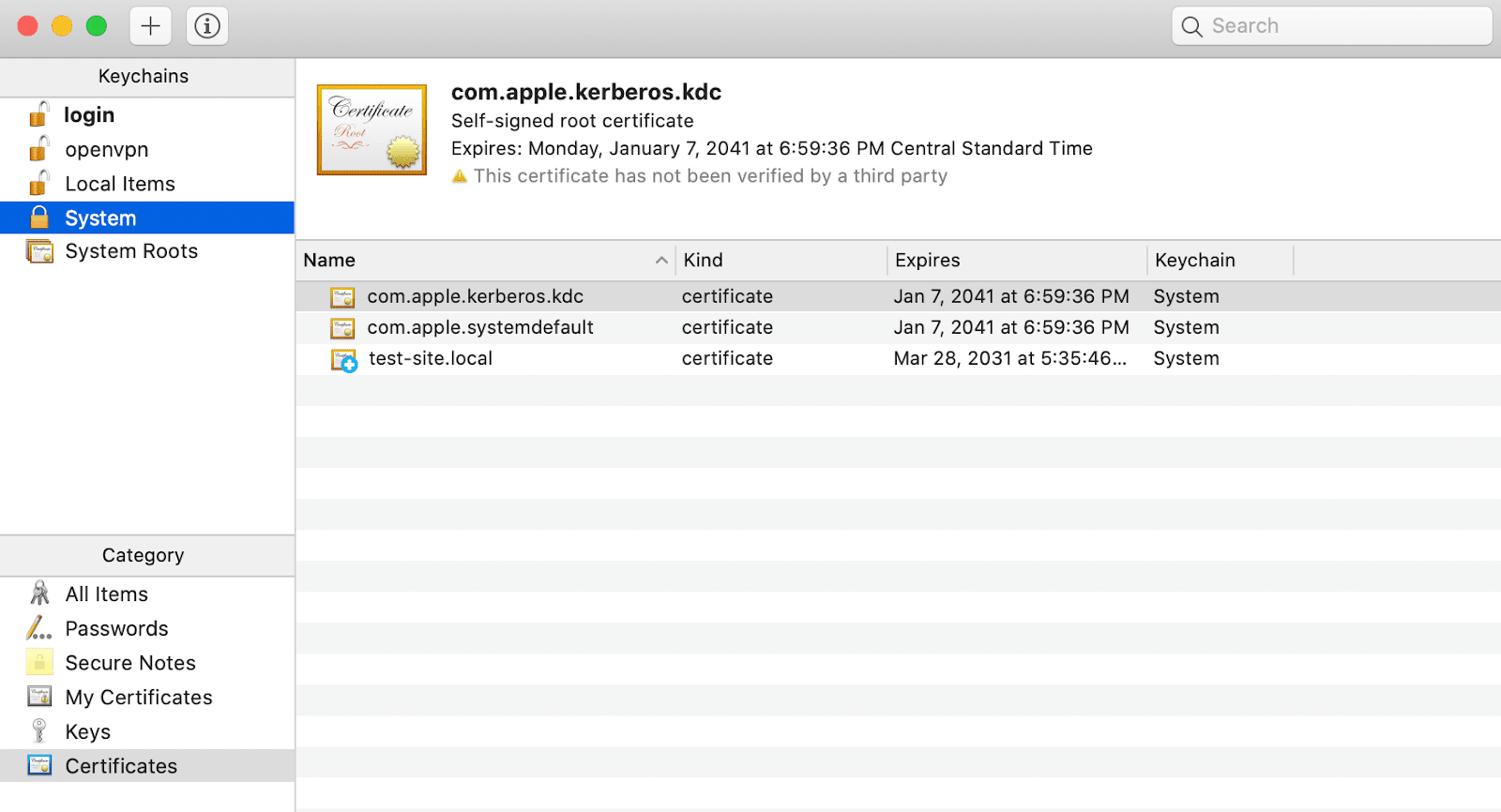
You can select certificates individually and delete them manually. If you spot a certificate for the website you’re trying to access, delete that one first, then check to see if the SSL connection error persists.
At this stage, if all else fails, temporarily disable your antivirus software and firewall . We suggest this as a last resort because, in most cases, your antivirus software won’t cause issues with SSL connections.
If you try every fix and nothing works, you can assume that the SSL connection problem lies with the server.
2. How to Fix the SSL Connection Error in Firefox
Fixing SSL connection errors in Firefox works much the same as with other browsers. You can follow the instructions in the last section to implement the following fixes:
- Check your system’s date and time and adjust them.
- Clear your local SSL slate.
If neither of those solutions works, then it’s time to clear your Firefox cookies and cache . To do so, go to the Options menu and jump to the Privacy & Security tab. Then click on the Clear Data button under Cookies and Site Data :

Try accessing the website with the SSL connection error once more. If your browser fails to establish a connection, check to see whether there’s a new version of Firefox that you can update.
3. How to Fix the SSL Connection Error in Safari
So far, we’ve covered multiple fixes for the SSL connection error that work across OSs. If you’re using Safari, start by following the same instructions given under the Google Chrome section:
- Clear your local SSL slate in macOS.
If the SSL connection error persists, you can move forward and clear your Safari cookies and cache . If you’re using an iMac, Macbook, iPhone, or iPad, the exact instructions apply here:
- Open the Safari Settings menu.
- Click on Clear History .
With that out of the way, try to access the website that gave you an SSL connection error before. The error should be gone now unless you’re dealing with a server-side configuration issue.
4. How to Fix the SSL Connection Error on iPhones and iPads
The process for fixing the SSL connection error on an iPhone or an iPad is identical to doing so on macOS. First, you need to check if your device’s date and time are synchronized. To access your mobile device’s date and time settings:
- Open the Settings app and select General > Date & Time .
- Check if the Set Automatically option is enabled. If it isn’t, turn it on.
- Manually check if your device is using the correct time zone.
After updating your date and time settings, you can move on to clearing your browser’s cookies and cache . To do so, open the Settings app and select Safari > Clear History and Website Data :
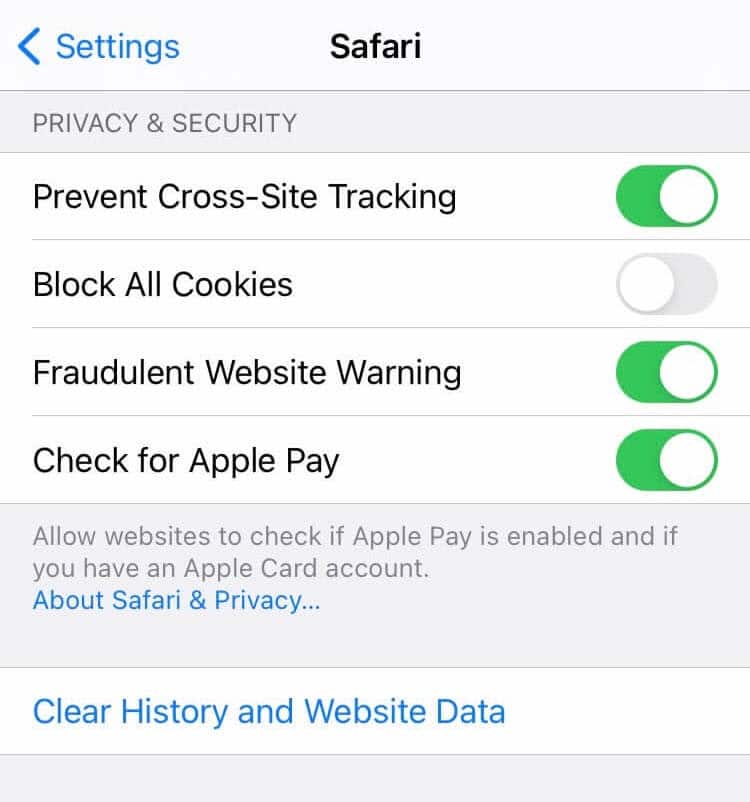
If you’ve installed a different browser on your iOS device, the process should still be similar.
Unfortunately, the most recent versions of iOS have removed the option to clear your SSL slate on your iPhone or iPad, so this is not a viable solution. If none of the fixes above work, you can assume the problem is server-side.
5. How to Fix the SSL Connection Error on Android
Fixing the SSL connection error on Android is relatively simple. First, go ahead and check your time and date settings to see if they’re accurate.
Open the Settings app and tap on General Management > Date and time . Then check if the Automatic date and time setting is enabled:
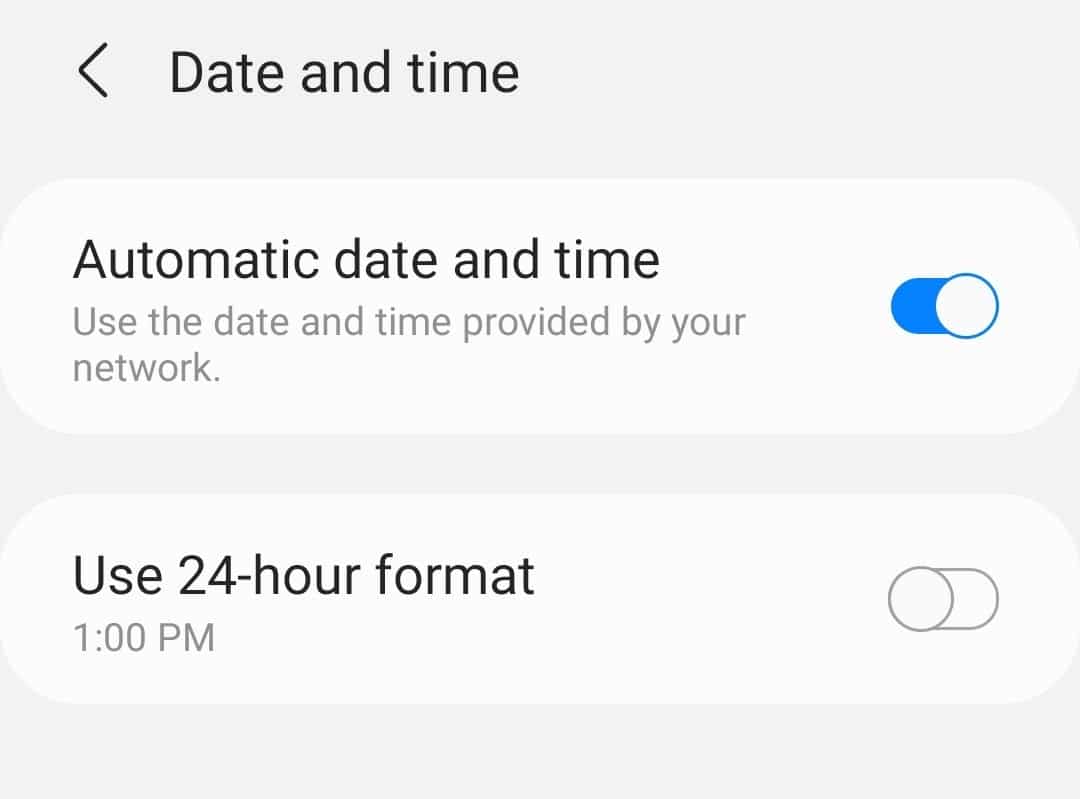
It’s important to note that, like iOS, Android doesn’t include an option for clearing your SSL slate or deleting individual certificates. What you can do to fix SSL connection errors is to clear your Chrome browsing data. To do so:
- Open the Chrome browser and access its Settings menu.
- Go to Privacy and security .
- Tap on Clear browsing data .
- Select your browser’s Cookies and site data and Cached images and files options, then tap on Clear data.
After clearing your Chrome website data, check if the SSL connection error persists. If it does, the chances are that it’s a server-side configuration issue.
6. How to Fix the SSL Connection Error on Facebook
If you run into an SSL connection error on Facebook , you can be sure that it’s not a server-side issue. That means you’re dealing with a local configuration problem. Here are the fixes that you should implement:
- Adjust your local time and date settings.
- Clear your browser’s cache and cookies.
- Clear your OS’s SSL slate or delete any local certificates for Facebook.
You can find instructions about adjusting your date and time settings on Windows and macOS within the Google Chrome section of this article. We also have instructions on clearing your browser’s cookies and cache for Chrome, Firefox, and Safari.
7. How to Fix the SSL Connection Error on Gmail
You won’t run into SSL connection errors while trying to access Gmail using mobile apps. However, SSL errors might pop up if you’re using Chrome, Firefox, or Safari to access Gmail’s web service. In that case, you should:
- Adjust your local time and date settings (check the Google Chrome section above for instructions).
- Clear your OS’s SSL slate or delete any local certificates for Gmail.
If everything else fails, you can access Gmail using a mobile app while you try disabling your firewall temporarily or updating your browser to its latest version.
8. How to Fix the SSL Connection Error on YouTube
SSL connection errors on YouTube are likely due to local configuration errors within your OS or browser. If you run into an SSL error in YouTube:
- Clear your OS’s SSL slate or delete any local certificates from YouTube.
We provided instructions on clearing your browser’s cache and cookies for Chrome, Firefox, and Safari earlier in this post. Likewise, you can find step-by-step guides on how to clear your SSL slate by checking the Chrome and Safari instructions in the previous sections.
SSL connection errors can come in a lot of shapes and sizes. If you’re dealing with a server-side error, there’s often little that you can do except wait for the site’s owner to fix it or proceed with an unsafe connection.
That said, you can attempt several local configuration fixes that may solve this issue, including:
- Adjusting your time and date settings.
- Clearing your browser’s cookies and cache.
- Clearing your OS’s SSL slate.
If you’re still facing SSL connection errors with your website, please leave a comment below. Kinsta clients can also reach out to our support team to get any SSL errors fixed.
Salman Ravoof is a self-taught web developer, writer, creator, and a huge admirer of Free and Open Source Software (FOSS). Besides tech, he's excited by science, philosophy, photography, arts, cats, and food. Learn more about him on his website , and connect with Salman on Twitter .
Related Articles and Topics

Powerful Managed WordPress Hosting

WordPress Security – 19 Steps to Lock Down Your Site
- Website Security
- Application Development
This fixed it! I was having a problem with maps in my vehicle and my iPhone 11 (iOS 15.2). Getting this displayed on my vehicle’s screen “an SSL error has occurred and a secure connection to the server cannot be made.” All I needed to do was clear my history and website data. Thank you!
Could you add how to fix it for PlayStation please? I’ve been looking for a while and I was hoping this would tell me how to do it but it didn’t.
Leave a Reply Cancel reply
By submitting this form: You agree to the processing of the submitted personal data in accordance with Kinsta's Privacy Policy , including the transfer of data to the United States.
You also agree to receive information from Kinsta related to our services, events, and promotions. You may unsubscribe at any time by following the instructions in the communications received.
Safari User Guide
- Get started
- Go to a website
- Bookmark webpages to revisit
- See your favorite websites
- Use tabs for webpages
- Import bookmarks and passwords
- Pay with Apple Pay
- Autofill credit card info
- View links from friends
- Keep a Reading List
- Hide ads when reading
- Translate a webpage
- Download items from the web
- Add passes to Wallet
- Save part or all of a webpage
- Print or create a PDF of a webpage
- Interact with text in a picture
- Change your homepage
- Customize a start page
- Create a profile
- Block pop-ups
- Make Safari your default web browser
- Hide your email address
- Manage cookies
- Clear your browsing history
- Browse privately
- Prevent cross-site tracking
- See who tried to track you
- Change Safari settings
- Keyboard and other shortcuts
Change Security settings in Safari on Mac
To change these settings, choose Safari > Settings, then click Security.
Open Safari for me

How to Clear the SSL State in Most Popular Browsers?

When you encounter issues with secure websites, clearing the SSL state might be the solution you need. It’s a simple process that involves navigating through your browser’s settings to refresh the SSL cache, which can resolve connection problems and ensure a smoother browsing experience.
Whether you’re using Chrome, Edge, Firefox, or Safari, each browser has a straightforward method for doing this. This article will show you how to clear the SSL state . But first, let’s see what SSL slate is and why you should clear it periodically.
What Is the SSL State?
The SSL state refers to information stored about your current SSL/TLS connections . When you visit a website, your browser uses SSL certificates to verify the site’s authenticity and encrypt the data exchanged . This process protects sensitive information like passwords and credit card numbers.
The SSL cache is where your browser stores these SSL states temporarily to improve connection speed and efficiency. When you revisit a site, your browser doesn’t need to go through the entire SSL handshake process again. It simply pulls the necessary information from the SSL cache, making your browsing experience smoother and faster.
However, the SSL state can become corrupted, leading to connection errors or security warnings. Since the SSL state includes the session keys , session IDs, and the SSL certificate details, any update or misconfiguration could cause SSL connection errors and website outages.
What Does Clearing the SSL State Do?
Clearing the SSL state removes stored SSL certificates and session data from your browser’s cache, ensuring a fresh and secure connection the next time you visit a site. You effectively reset any saved SSL certificate cache that might be causing issues with secure connections.
This action forces the browser to re-establish SSL connections with up-to-date certificates, preventing you from using potentially compromised or outdated SSL data.
Here’s what your browser does when you clear the SSL Slate:
- Removes Stored Certificates : Any SSL certificates stored from previous secure connections are deleted.
- Clears Session Data : Information about ongoing secure sessions is wiped, meaning you would need to re-establish secure connections.
- Resolves Connection Issues : If you’re having trouble accessing a secure site, clearing the SSL slate can fix errors caused by outdated or corrupted data.
- Improves Security : Ensures that old, potentially insecure information isn’t used in future connections.
How to Clear the SSL State in Popular Browsers
You can quickly clear the SSL state through the settings menu in Chrome, Edge, Firefox, and Safari. Let’s walk through the steps for each browser so you can ensure a smooth and secure browsing experience.
How to Clear the SSL State in Chrome
- Start the Windows Control Panel.
- In the Find a setting text box, type “ internet options ,” and then click Internet Options.
- Click the Content tab.
- In the Certificates section, click Clear SSL state , and then click OK.
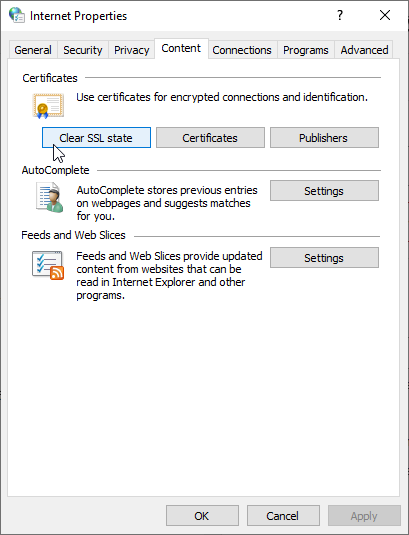
These steps apply to clearing the SSL state for all browsers on your Windows machine, not just Chrome because they clear the system’s SSL cache.
However, you can clear the SSL cache within Google Chrome by restarting the browser. Here are the steps:
- Open Google Chrome.
- Type chrome://net-internals/#dns in the address bar and press Enter.
- Click on the “ Clear host cache ” button.

How to Clear the SSL State in Edge
- Launch the Microsoft Edge browser.
- Click on the three horizontal dots (menu icon) in the browser’s top-right corner. Select Settings from the dropdown menu.
- Scroll down and click on Privacy, search, and services in the left-hand menu.
- Under the Clear browsing data section, click on Choose what to clear .
- In the pop-up window, ensure that Cached images and files option is selected. This will help clear any SSL state-related data.
- You can optionally select other types of data, such as cookies and site data, for a more comprehensive clean.
- Click the Clear now button to complete the process.
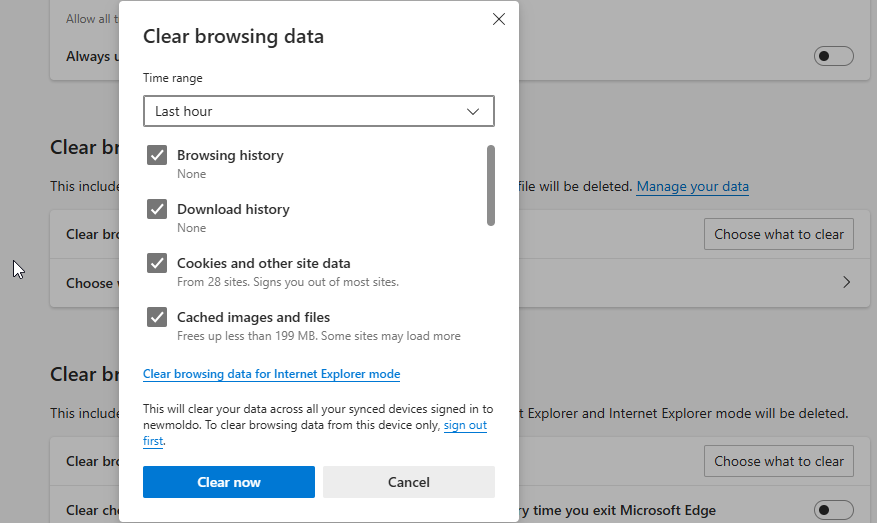
How to Clear the SSL State in Firefox
- You can either click on the menu button (three horizontal lines) in the upper-right corner of the Firefox window and select “ History ” or press Ctrl-Shift-H to open the History sidebar directly.
- Click “ Clear Recent History ” from the History menu or press Ctrl-Shift-Delete to open the “ Clear All History ” dialog box.
- In the “ Time range to clear ” drop-down menu, select “ Everything .”
- Ensure that the “ Active Logins ” check box is selected. For clearing the SSL state specifically, select “ Cache ” as cached SSL certificates and sessions may be stored there.
- Click “ Clear Now ” to complete the process.
These steps will clear the SSL certificate cache and other selected browsing data in Firefox. Note that this process clears more than just the SSL state—it also clears cookies and cache.
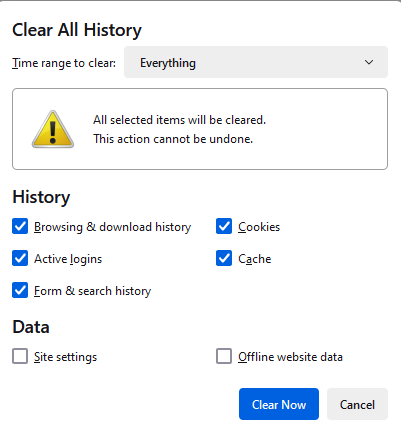
How to Clear the SSL State in Safari
- Launch the Safari browser on your Mac.
- In the menu bar at the top of the screen, click “ Safari ” and select “ Preferences ” from the drop-down menu. Alternatively, use the keyboard shortcut ( Command + comma ).
- In the Preferences window, go to the “ Advanced ” tab. Ensure the “ Show Develop menu in menu bar ” option is checked.
- Close the Preferences window. In the menu bar, you will now see a “ Develop ” option.
- Click “ Develop ” in the menu bar and select “ Empty Caches ” from the drop-down menu. This action will clear the cache, which includes SSL certificate-related data.
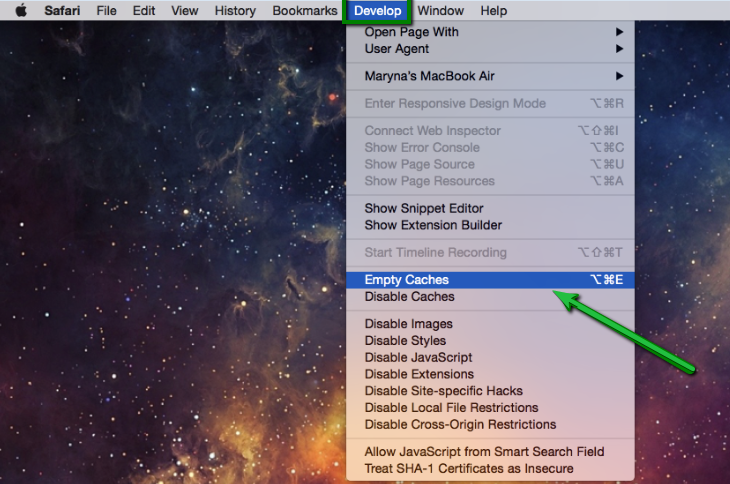
Bottom Line
Now that you know how to clear the SSL state, troubleshooting potential SSL connection errors will be much easier. Follow the steps outlined for your specific browser, refresh your SSL state, and resolve potential connection issues.
Don’t forget to restart your browser afterward to ensure the changes take effect. Stay proactive about your online security and enjoy seamless browsing by regularly clearing the SSL state in your preferred browser.
Save 10% on SSL Certificates when ordering today!
Fast issuance, strong encryption, 99.99% browser trust, dedicated support, and 25-day money-back guarantee. Coupon code: SAVE10

Experienced content writer specializing in SSL Certificates. Transforming intricate cybersecurity topics into clear, engaging content. Contribute to improving digital security through impactful narratives.
The valuable part of your digital certificate is the unique, verifiable URL. However, it's also nice to have a hard copy of your credential. Here we show you how to download and print your certificate. May 29, 2024 • Knowledge
Information, article details.
Important Notes:
- Accredible is a 100% digital credential service. We don't send out paper copies of certificates. However, you can download and print your own certificate by following the steps in this article.
- Some of our issuers send out a formal paper version of certificates to complement the digital version. To determine whether your issuer provides this service, we recommend that you contact them directly to ask. Unsure of how to contact your issuer ? Click here .
Depending on your issuer, the 'PDF' function may only be visible if you are logged in to your
credential view. Need help logging in? Click here .
Download a PDF Version of your Certificate
- Navigate to the certificate that you would like to download.
- Along the bottom of the credential window, click the 'PDF' button.
- A PDF version of your credential will appear. Save this onto your computer.
IMPORTANT NOTE:
Download and Print the Certificate
To print your certificate, you need to download a PDF copy first:
- A PDF copy of your certificate will open in a new browser window. Click on the download icon at the top of your PDF window.
- Open the PDF version of your certificate now downloaded to your computer. Go to 'File' at the top of your screen, then click on 'Print.'
- Follow the printing instructions of your computer.
On modern-day browsers, you can seamlessly view and print your certificate without leaving your browser.
Has this article helped you? Let us know!
If you wish to inform us about any improvement that you think could be done on this page, you can send us an email to [email protected] .
800 West El Camino Real, Suite 180, Accredible, Mountain View, CA, 94040
More Digital Credential Resources
How To Remove Blocked Plug-In on Mac (2024 Updated Guide)
Safari’s plugin management system heavily impacts your overall internet browsing experience. People use it to enhance privacy and security, improve productivity, and automate certain tasks. However, constantly having the “Blocked Plug-In” error pop up on your Mac when viewing PDF files can quickly become a major headache.
It prevents certain web content, like PDFs, webpages, videos, or other interactive features, from loading correctly. This issue indicates faulty plugins or Safari browser glitches. That said, you don’t necessarily have to switch to another default browser—here are some troubleshooting steps to try.
If you’re concerned about add-ons, plugins, or extensions that can create pop-ups and potentially compromise your data, the best solution would be an app with robust defense. For example, Intego can protect sensitive data by blocking digital intruders, thanks to its proactive monitoring that allows you to browse the web with your privacy intact.
➡️ Try Intego for free
How To Remove Blocked Plug-In On Your Mac
1. disable or remove all safari plugins.
Time needed: 5 minutes
Try disabling all your active plugins on Safari. It’s a drastic yet effective way to pinpoint whatever is stopping your browser from displaying web content properly:
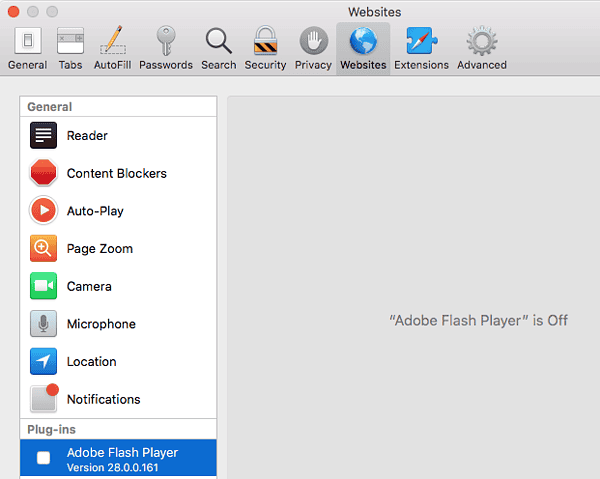
Next, if you want to remove all the plugins from the system. Simply visit /Library/Internet Plug-Ins/ to access the files. Then, you can drag all the plugins to the trash and it will be deleted permanently.
To identify if the issue is isolated to any particular plugin, try adding them individually and check if it is resolved.
2. Try Another Browser
Since users are primarily seeing this error on Safari, you can try using a different browser, such as Opera One . See if the issue persists. While it doesn’t actually solve the problem at hand, it’s a quick, easy solution if you need to access something only urgently.
3. Update Plugins
An outdated plugin could also cause these errors. Updating your plugins to their latest versions might resolve the incompatibility issues that are blocking specific web content. Make sure you visit the official websites of your extensions, of course.
4. Update Your Browser
Lastly, you can also update your Safari browser . If this is a known issue on older Safari versions, Apple might have already resolved it in its more recent releases. Whatever the case, using the latest version improves security, performance, and compatibility with web content, including plugins.
- Go to the Apple menu and open System Preferences.
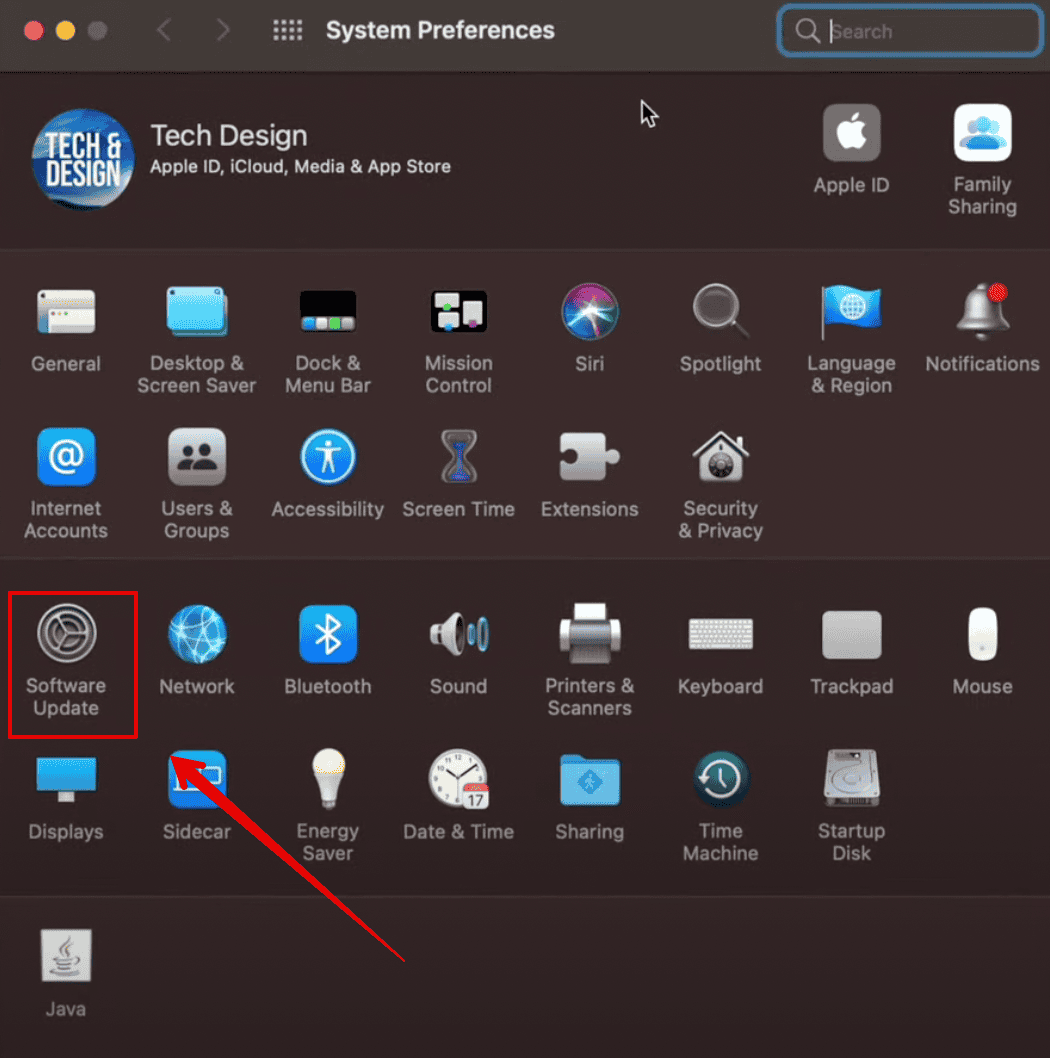
- Wait for a few seconds while the system checks for any available updates.
- Follow the on-screen instructions to complete the update.
Contact Apple Support if you still can’t remove the Blocked Plug-In error on your Mac. Although unlikely a hardware defect, certified technicians can still guide you through more complex, personalized troubleshooting solutions.
Leave a Reply Cancel reply
You must be logged in to post a comment.
This site uses Akismet to reduce spam. Learn how your comment data is processed .
- Kanika Modi

COMMENTS
Part 1: Understanding Safari Certificate Errors. An "Invalid Certificate Error" on Mac, specifically when encountered in a web browser like Safari, indicates that there is an issue with the SSL/TLS certificate presented by a website.SSL (Secure Sockets Layer) and its successor TLS (Transport Layer Security) are cryptographic protocols that provide secure communication over networks, such ...
To fix the problem, go into settings, then scroll down and tap safari, once in safari tap the option "Hide IP Address" and select "off" for the option. After you select off go back to the safari app and see if the pages load. Once fixed if you prefer you can then go back into settings, safari, hide ip address and change the option to ...
From Safari Help. Change the trust settings of a certificate. You can view or change a certificate's trust policies in Keychain Access. Open Keychain Access for me. In the Category list, select a category. Select a certificate, then choose File > Get Info. Click the Trust disclosure triangle to display the trust policies for the certificate.
Jeff N 2021-12-19 04:20:08. HOW TO DOWNLOAD, INSTALL, AND SET THE NEW SECURITY CERTIFICATE FOR GOOGLE CHROME & SAFARI ON EL CAPITAN This worked 100% on my 2008 Mac Pro Tower running El Capitan (extremely fast and reliable for its age, but cannot install Sierra on it).
In any of these cases, you may see a "Not Secure" or "Website Not Secure" message in Safari: The website is encrypted, but its certificate is expired or illegitimate. The website's certificate is valid but the version of TLS is not secure (TLS version 1.1 or earlier). The website is unencrypted and asking you to enter password or credit ...
So, when you have an invalid certificate error, you need to check your date and time settings. Within a few minutes, the issue should disappear. Click the Apple menu and choose System Settings. Select General > Date & Time. Ensure that the "Set date and time automatically" option is turned on. Quit System Settings.
To get started, browse to Apple > System Preferences > Network. Find the network option in the preferences. From this window, select your connection, then click on the Advanced tab, followed by DNS. Next, click on the (+) icon next to IPv4 or IPv6 addresses. Click on the DNS tab.
Enter them and select the Verify option at the side. 5. Click the Start button, and in the following window, click Repair. 6. Finally, click Start one more time and open Safari when the process finishes. Revisit the website on which the certificate was detected as invalid to ensure the problem is solved.
This seems to be because Safari and Chrome use the OS root certificate store and Firefox uses its own, and El Capitan is not being updated. From here there are: Trusted certificates establish a chain of trust that verifies other certificates signed by the trusted roots — for example, to establish a secure connection to a web server.
A certificate, also known as a "digital certificate" or a "public key certificate," is a file that helps keep web communications secure. Certificates are issued by trusted organizations, such as VeriSign, Inc. or RSA Security, Inc. When you visit an encrypted website—for example, to do online banking—Safari checks if the site's ...
Next, after you go through the description of the warning, click on the "visit this website" hyperlink located all the way at the bottom, as shown below. Now, you'll get a pop-up in Safari. Choose "Visit Website" to confirm your action and access the website. And there you have it, you're viewing the site. Again on the Mac you'll ...
Blanking out the site's name really makes such questions difficult and/or annoying to answer, because the answer depends not only on the certificate itself but also on the webserver's configuration - information about OCSP stapling was obtained by directly testing your webserver's TLS response, and of course nobody knows whether the provided screenshots include all certificate details, or ...
19. Press "Show Details", then press "Visit this website" on the bottom, and the "Visit Website" from the pop up. Note: if you're still getting this issue after installing the cert, try to edit in keychain access app: locate the cert that you just installed and double click to open the cert, expand "Trust" and change "When using this ...
To fix this, you need to clear your browser's cache and cookies. To clear the cache on Chrome, click the three-dot menu icon, then navigate to More Tools > Clear Browsing Data. Next, select "All time" from the time range drop-down and check the boxes next to "Cookies And Other Site Data" and "Cached Images And Files."
Click Clear SSL state. 7. Clear your cache and cookies. You can often resolve SSL errors by deleting certain files that websites save to your computer. Clearing your cookies, as well as clearing your cache, can fix a wide variety of browsing errors in addition to certificate malfunctions. 8.
Safari's client certificates and related preferences are stored in Keychain Manager with a kind of certificate.. When you select a certificate to use with a web site, it stores another entry in the Keychain Manager with a kind of identity preference.Unfortunately, by default it stores it only for the exact page you were on.
If you click the Show Details button and then the view the certificate link, you can confirm that the domain name does not match the certificate. Solution: Make sure that the common name and/or a subject alternative name listed in the certificate matches the website's domain name. Go to top.
Step 8 ⇨ Reset browser SSL state (Windows Only) The SSL State is a cache on the system with SSL certificate information. Sometimes this cache needs to be purged in order for the browser to see a newer certificate authority who may have recently renewed a certificate. There is a separate process for clearing this cache data on Windows systems.
1. It seems that Safari tighten up the security policy by removing options that are considered as insecure. So, frankly spoken, if you try to fix your issue with a workaround or 'dirty hack' you just postpone it to a later date and browser version. The only way out is IMHO to get things done the right way and solve the problem.
However, SSL errors might pop up if you're using Chrome, Firefox, or Safari to access Gmail's web service. In that case, you should: Adjust your local time and date settings (check the Google Chrome section above for instructions).
In the Safari app on your Mac, use Security settings to turn security warnings on or off. Also enable or disable JavaScript. To change these settings, choose Safari > Settings, then click Security. Get a warning if the site you're visiting is a suspected phishing website.
On every browser except Safari, there are no issues with SSL. However, on Safari on a PC, we cannot access the site. When you try to browse to the site, you either receive a "Select a Certificate" prompt or, a "No Certificate Available" prompt. If you receive the "Select a Certificate" prompt and you choose a valid certificate, the prompt goes ...
Safari Version Affected: 13.0.x and newer. Description: Client-side certificates used for validating users through IIS may not work with the latest versions of MacOS and Safari. This means that any web browser login requiring the user to present a certificate as part of their authentication may potentially have issues.
How to Clear the SSL State in Chrome. Start the Windows Control Panel. In the Find a setting text box, type " internet options ," and then click Internet Options. Click the Content tab. In the Certificates section, click Clear SSL state, and then click OK. These steps apply to clearing the SSL state for all browsers on your Windows machine ...
Head to System Preferences on your Macbook and then click Network. Next, inside the Wi-Fi tab, click the 'Advanced' button and head to DNS settings. Add Google's Public DNS - '8.8.8.8' and select the OK button to make changes. Refresh the site to see if it loads now. Conclusion: Final Thoughts.
Along the bottom of the credential window, click the 'PDF' button. A PDF copy of your certificate will open in a new browser window. Click on the download icon at the top of your PDF window. Open the PDF version of your certificate now downloaded to your computer. Go to 'File' at the top of your screen, then click on 'Print.'.
Go to the Apple menu and open System Preferences. Click on Software Update. Image Source: YouTube. Wait for a few seconds while the system checks for any available updates. Follow the on-screen ...